ร่วมสํารวจการเปลี่ยนแปลงพื้นที่หนึ่งในย่านเก่าของพระนคร จากพื้นที่วังเก่าและที่ตั้งของกระทรวงต่างๆ สู่ย่านการค้าที่มีชีวิตชีวาผ่านเรื่องเล่าจากอดีต
Explore the transformation of Phra Nakhon's historic district, from the old palaces and ministries to a lively commercial hub. Discover the stories of the past and journey through time.


เตรียมตัวย้อนเวลาไปสู่อดีตกับเราเพื่อค้นพบย่านที่มีเรื่องราวน่าสนใจมากมาย!
Prepare to be whisked away through time while uncovering the most delightful neighborhoods!
เราจะพาคุณไปทําความรู้จักกับย่านเฟื่องนคร และ 3 แพร่งสุดฮิปกับหลายเรื่องเล่าสนุกๆเพื่อเปิดมุมมองของย่านในด้านประวัติศาสตร์ ชุมชน และสถาปัตยกรรม
Join an adventure to explore Fueang Nakhon and Sam Phraeng's vibrant neighborhoods, uncovering captivating tales about their history, community, and architecture.

Introducing Our Audio Guide
ทําความรู้จักแต่ละสถานที่ให้มากขึ้นด้วย audio guide ของเรา ที่มีอยู่ในแต่ละสถานที่ โดยเราจะนําทางคุณไปตามเส้นทางต่างๆให้คุณสามารถ เดินไป ดูไป และฟังไปแบบเพลินๆเลย
Our Audio guides are available for each location, guiding you along various routes for you to enjoy a next-level walking experience that makes you feel like an explorer.

Scout through your lens with IG filters
สํารวจและเก็บภาพความทรงจําเก๋ๆที่ photo spot ผ่าน instagram filter ของเรา เพื่อนําไปเป็นส่วนลดในร้านพาร์ทเนอร์ในแต่ละเส้นทางของเราได้ด้วย!
Snap and cherish moments at our photo spot with our Instagram filter! you can score some discounts at our partner shops while exploring our routes.
All Destinations
The Roots Routes
สตูดิโอออกแบบประสบการณ์ทางวัฒนธรรมที่เชื่อมโยงนักเดินทางกับชุมชนท้องถิ่นผ่านการเล่าเรื่องและกระบวนการออกแบบขององค์ประกอบทางวัฒนธรรม
A Cultural Experience Design Studio connecting travelers and local communities together through storytelling and the design process of cultural elements



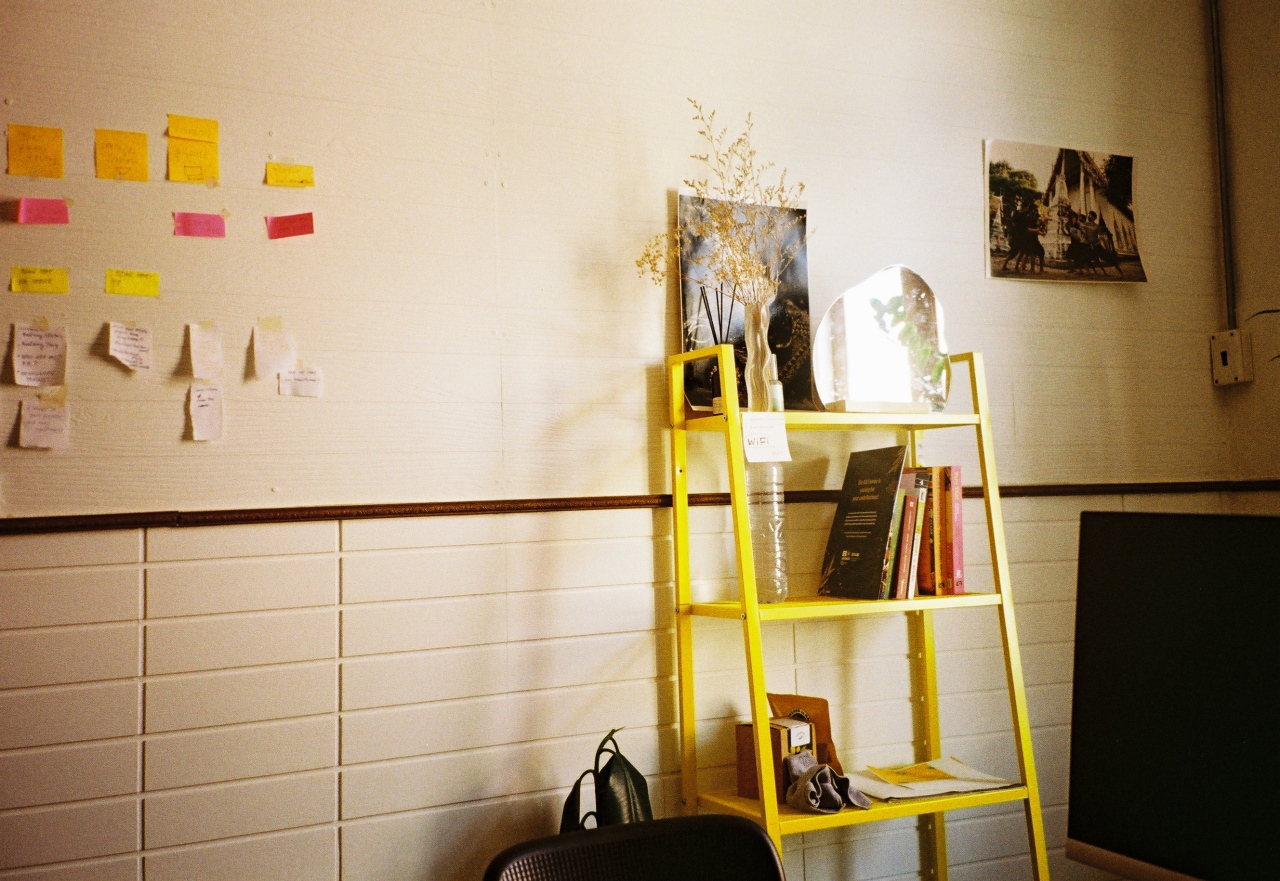

Walking Path Overview
เราจะพาไปสํารวจจุดหมายแรกที่ The Roots Routes Studio ซึ่งตั้งอยู่ในอาคารดั้งเดิมที่ผ่านร้อนผ่านหนาวตามกาลเวลา พร้อมบอกเล่าเรื่องราวความเป็นย่านเฟื่องนครให้คุณได้ลองนึกภาพตามไปพร้อม ๆ กัน
On our first stop, let's explore The Roots Routes studio in its original building and conjure up images from the past of Fueang Nakhon area together through captivating tales!


เสน่ห์แห่งอาคารเก่าแก่ในย่านการค้าประวัติศาสตร์
The allure of old establishment in a historic commercial district.
The Roots Routes คือ Cultural Experience Design Studio หรือ สตูดิโอออกแบบประสบการณ์ทางวัฒนธรรมที่มุ่งมั่นที่จะเชื่อมโยงนักท่องเที่ยวกับชุมชนท้องถิ่นเข้าด้วยกัน ผ่านการเข้าใจเรื่องราวและการสัมผัสกับ Cultural Elements หรือองค์ประกอบทางวัฒนธรรมต่าง ๆ ในพื้นที่นั้น ๆ เช่น ศิลปะ หัตถกรรม ความรู้ ประเพณี ความเชื่อ และอาหาร
"The Roots Routes" is a Cultural Experience Design Studio committed to bridging the gap between travelers and local communities. We want to provide a one-of-a-kind travel experience that brings local culture and stories to light while engaging with diverse cultural elements in certain areas—such as art, handicrafts, knowledge, customs, beliefs, and cuisine.
สถานที่ทํางานของเราซึ่งตั้งอยู่ในย่านเฟื่องนครแห่งนี้ ทําให้เรากลายมาเป็นหนึ่งในผู้ก่อตั้งเครือข่าย Heritage Habitats ร่วมกับ CODE Studio และ Studio US ซึ่งถึงแม้แนวทางการออกแบบด้านวัฒนธรรมจะแตกต่างกันไป แต่จุดมุ่งหมายเดียวกันของเรา คือ การสืบทอดวัฒนธรรมและเรื่องราวในแถบท้องถิ่นให้คงอยู่ต่อไป
Our workspace in Fueang Nakhon has made us part of the Heritage Habitats network, where we collaborate with CODE Studio and Studio Us. Despite our different cultural design approaches, one goal that we share is to preserve and prolong local cultures for generations to come.
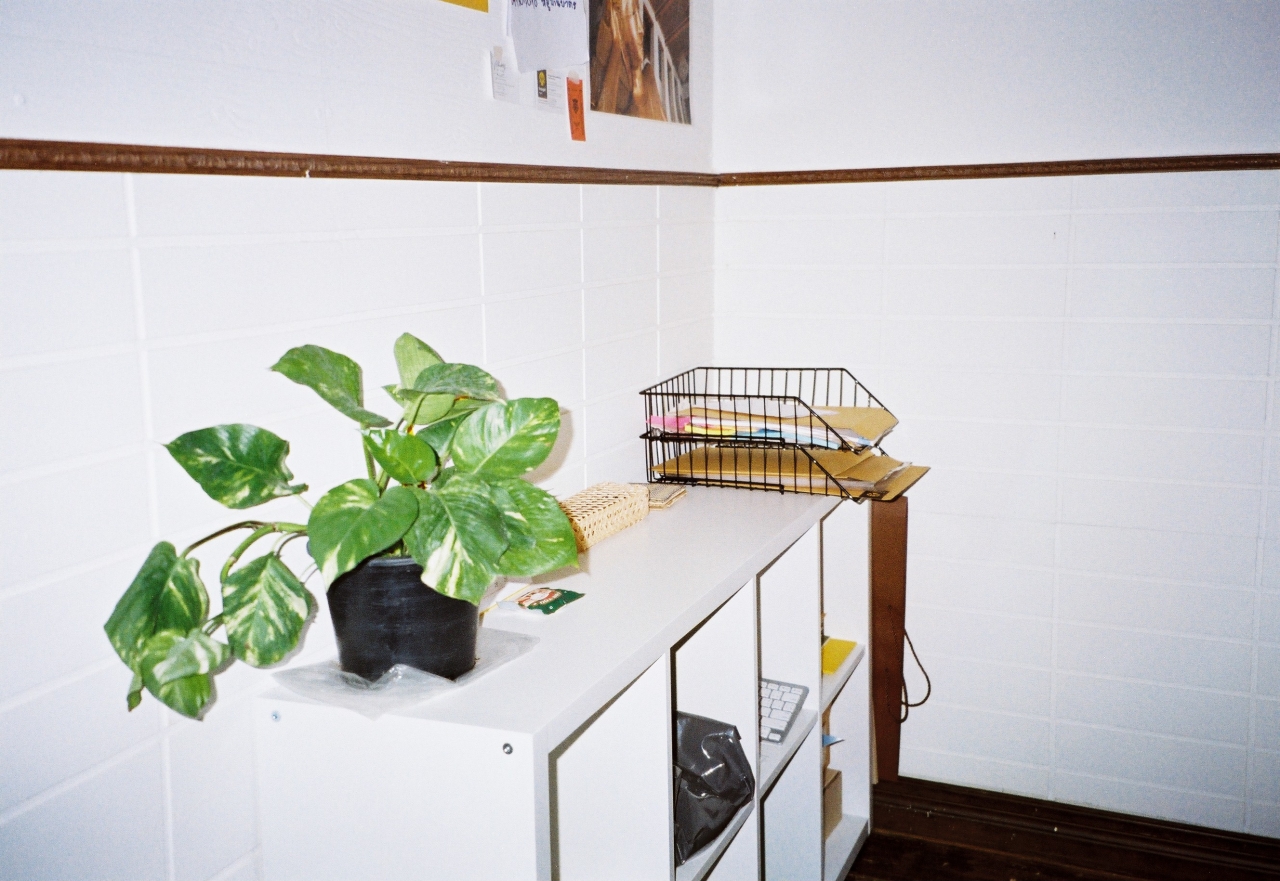

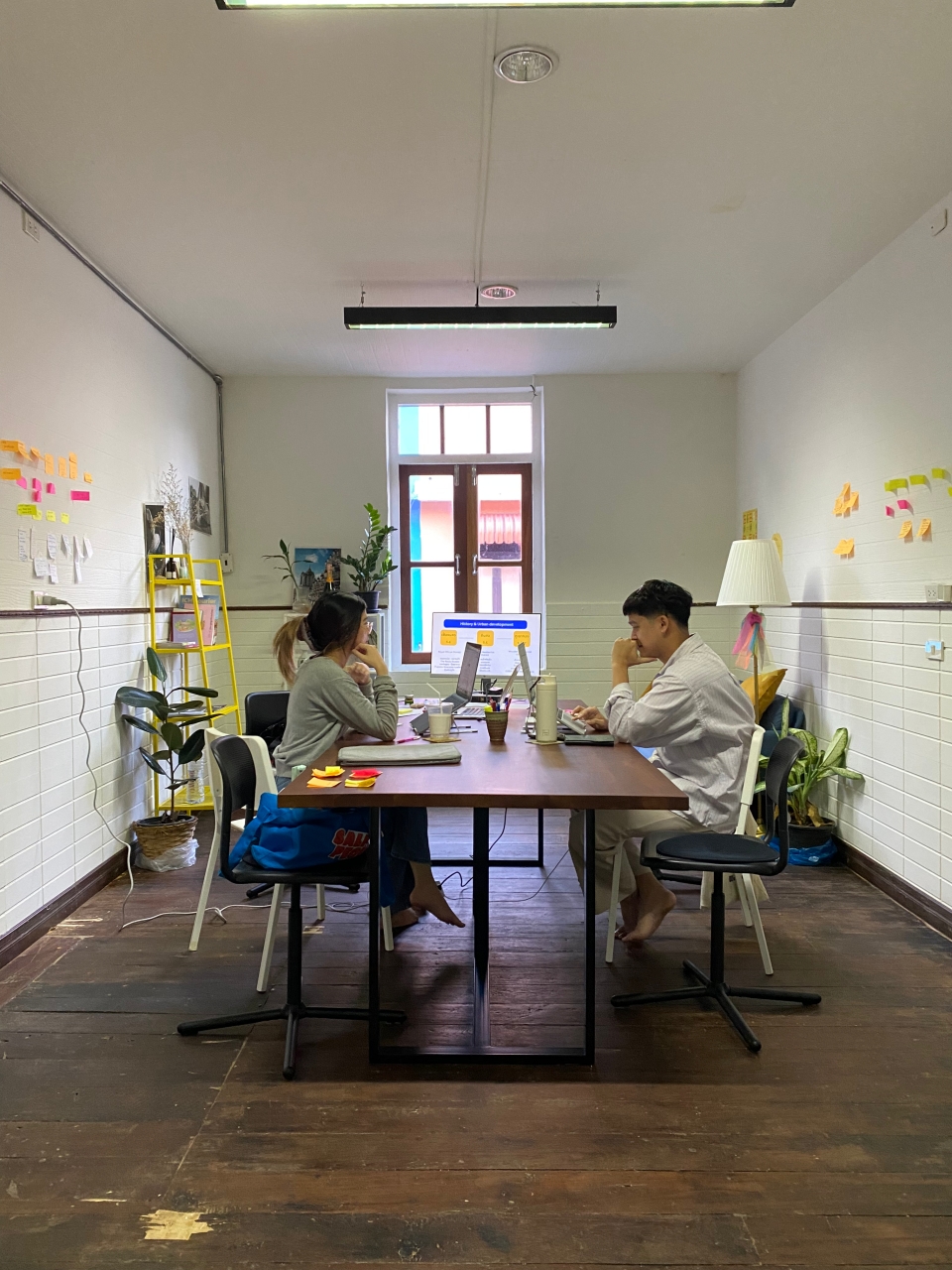
ตึก The Roots Routes ของเราที่ตั้งอยู่ ณ ซอยสุขา 1 ระหว่างถนนเฟื่องนครและถนนตีทองข้างวัดสุทัศน์นี้ ตัวอาคารยังคงโครงสร้างพื้นไม้เก่าและเสาไม้เดิมอยู่ นอกจากนี้ อีกจุดสังเกตหนึ่งคือลักษณะภายนอกของอาคารที่มีการผสมผสานสไตล์ Neo-classic ตะวันตก และคาดการณ์ว่าได้รับการสร้างขึ้นประมาณปี พ.ศ. 2450 ทําให้ตึกนี้มีอายุมากกว่า 116 ปีเป็นอย่างน้อยเลยทีเดียว
The Roots Routes building is located on Soi Sukha 1, between Fueang Nakhon Road and Tee Thong Road next to Wat Suthat. This charming abode boasts an original wooden floor and pillars, and its exterior design manifests a delightful blend of Western Neo-classical style. To top it off, the building has been around since 1907, making it a grand 116 years old already.
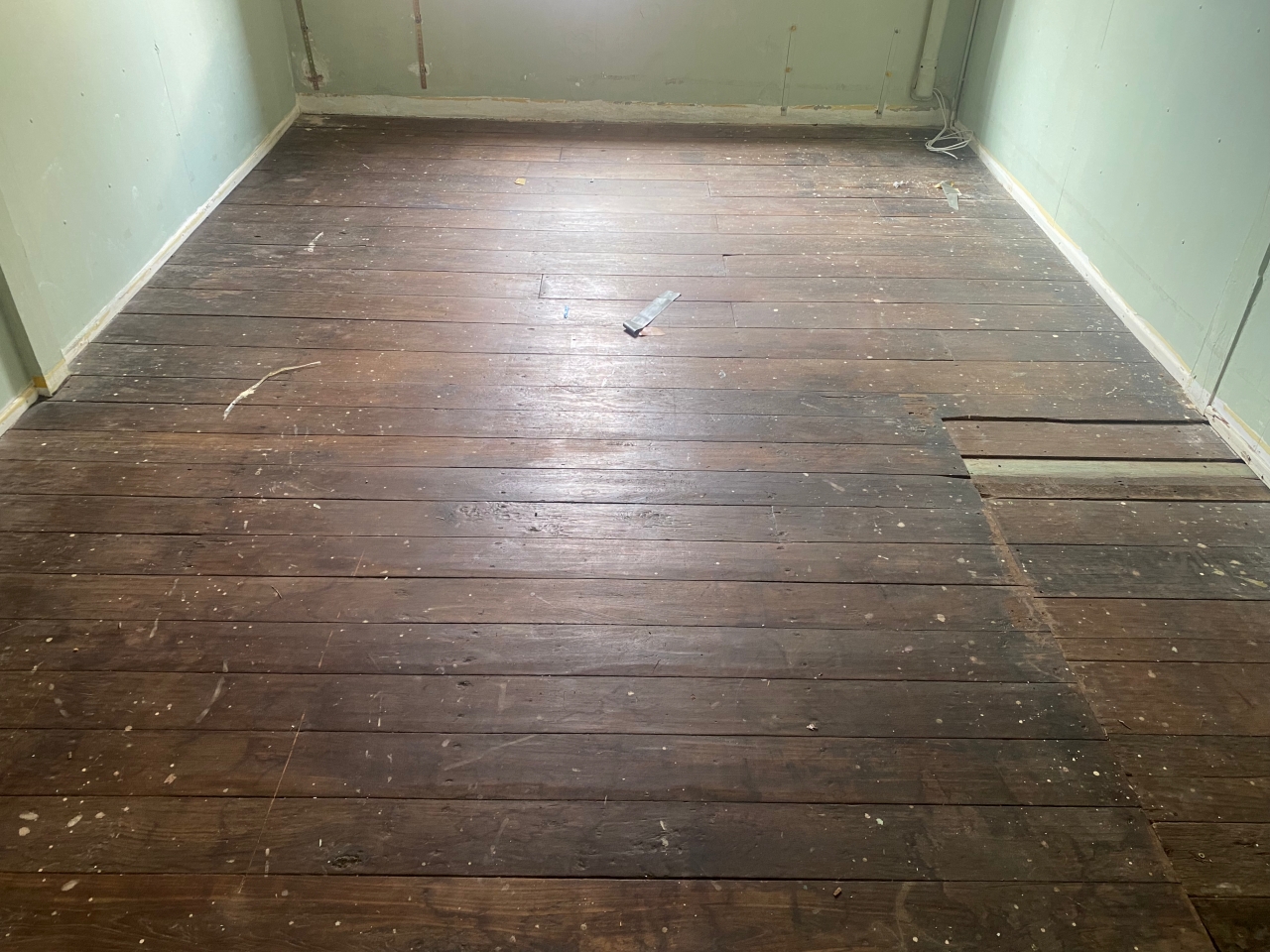


หากมองย้อนกลับไปยังอดีตย่านเฟื่องนคร ร่องรอยแห่งการเป็นย่านการค้ายังคงสะท้อนให้เราเห็นตลอดจนถึงปัจจุบัน เมื่อปี พ.ศ. 2406 ในสมัยรัชกาลที่ 4 ถนนพี่น้องที่มีชื่อคล้องจองกันทั้ง 3 สาย คือ เจริญกรุง บํารุงเมือง และเฟื่องนครได้ถูกสร้างขึ้น หลังจากเริ่มมีการสร้างตึกแถวตลอดแนวถนน เฟื่องนครกลายเป็นเส้นทางการค้าสําคัญที่มีธุรกิจจากนานาชาติเข้ามาจับจองมากมาย เปรียบได้กับถนนสุขุมวิทในสมัยนี้ซึ่งมักรายล้อมไปด้วยผู้คนมากหน้าหลายตาเข้ามาพํานักอาศัย
The Fueang Nakhon district was once the buzzing heart of commerce, and even now, the traces of its bustling past are still visible. Way back in 1863, during the reign of King Rama IV, threee neighboring streets with their rhyming titles, including Charoen Krung, Bumrung Mueang, and Fueang Nakhon, were built. These roads were soon flanked with shophouses, and before anyone knew it, Fueang Nakhon had become the go-to spot for many international businesses. Think of it as the Sukhumvit Road of its day, always swarming with residents and visitors alike.
Contributed by
The Roots Routes
Cultural Experience Design Studio ที่เชื่อมโยงนักเดินทางกับชุมชนท้องถิ่น โดยการเล่าเรื่อง และให้ความเข้าใจในองค์ประกอบทางวัฒนธรรม ผ่านกระบวนการออกแบบ
A cultural experience design studio connecting travelers with local communities, emphasizing storytelling, and cultural immersion through the design process.
Trok Mor Market
สํารวจตลาดที่มีชีวิตชีวาและการตามล่าของกินสุดอร่อยที่มาพร้อมกับโชคลาภ
Exploring a vibrant living market and tastiest treats hunt that comes with a stroke of luck


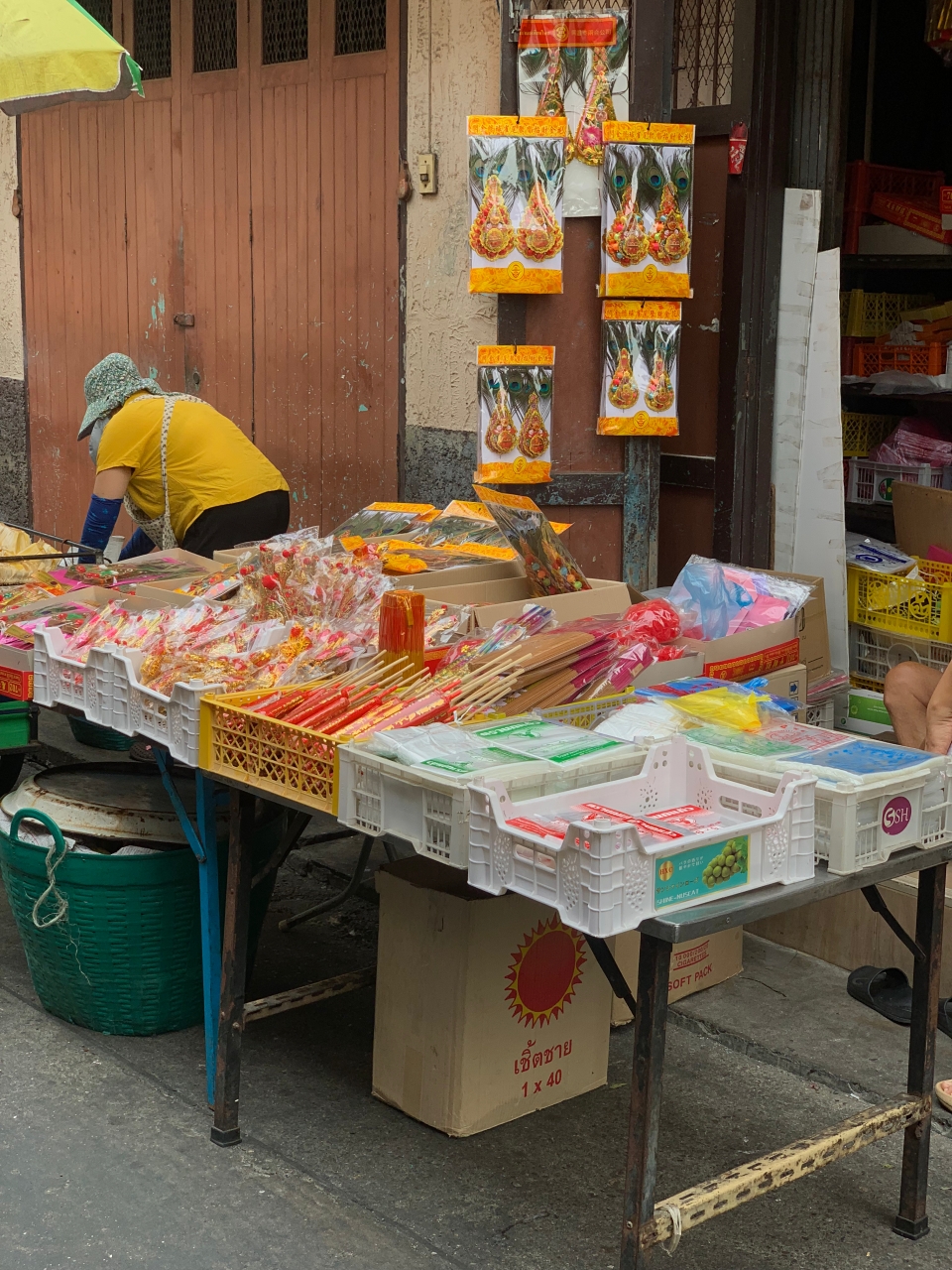

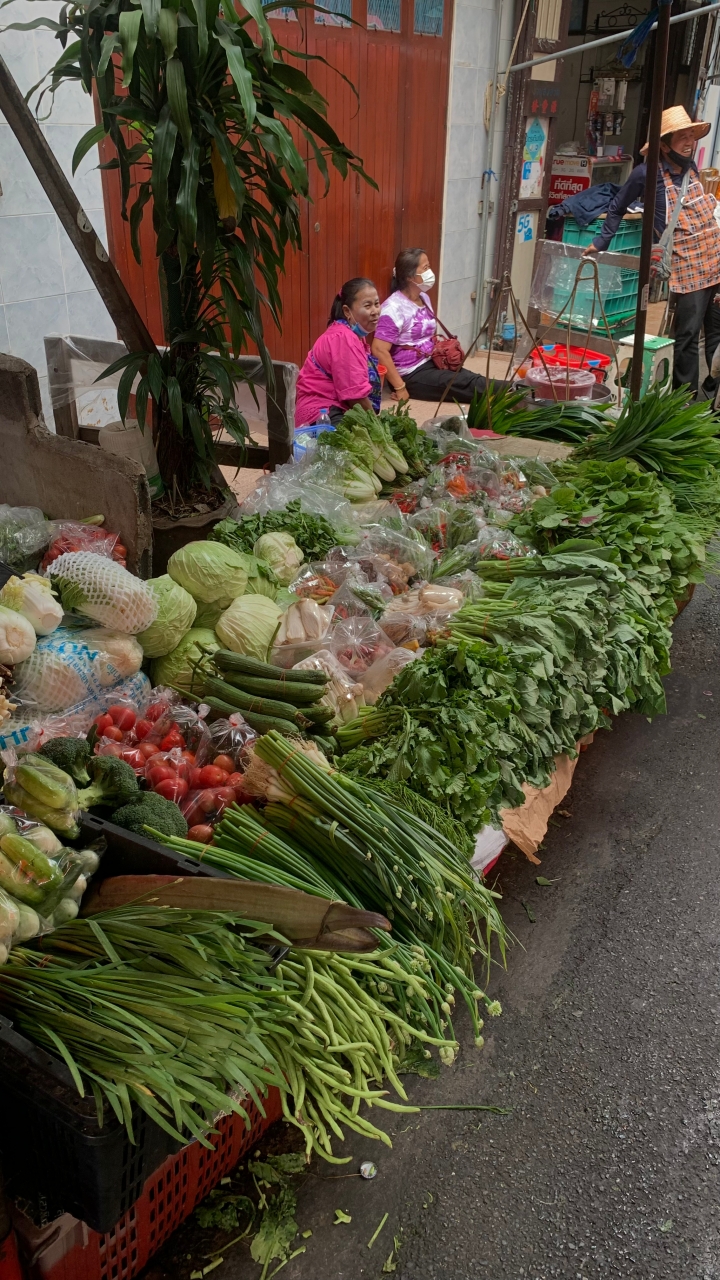
Walking Path Overview
เราจะพาคุณเดินลัดเลาะไปในตลาดเช้าสุดคึกคักที่เปิดมานานต่อเนื่องกว่า 70 ปี พร้อมค้นหาร้านสุดอร่อยในตลาดไปด้วยกัน
Let's stroll through a vibrant morning market with over 70 years of history and discover hidden culinary gems together!


เรื่องราวของตลาดตรอกหม้อที่ไร้ “หม้อ”
The story of the Pot Alley market without a "pot"
คุณเคยรู้มาก่อนไหมว่าชุมชนตรอกหม้อ เดิมมีชื่อเรียกว่า “ชุมชนเสาชิงช้า” ชื่อนี้มาจากสถานที่ตั้งของชุมชุนที่อยู่ใกล้กับเสาชิงช้านั่นเอง เมื่อ 120 ปีก่อน ชุมชนนี้เคยเป็นพื้นที่สําหรับทําหม้อดินขาย รวมถึงเก็บหม้อดินที่ทําเสร็จแล้ว ทําให้ชื่อ“ชุมชนตรอกหม้อ” ถูกเรียกมายาวนานจนถึงทุกวันนี้
Did you know that the Trok Mor community was once called the "Sao Ching Cha" or the Giant Swing community? This comes from the fact that it is located near the famous Giant Swing. About 120 years ago, this community used to make and sell clay pots, which were as well stored there. That's why this community became known as the Trok Mor community, meaning "Pot Alley" in Thai.
ช่วงแรก ๆ มีชาวมอญอาศัยอยู่กันมากมาย จนชาวจีนเริ่มเข้ามาสร้างชุมชนของตัวเองในบริเวณนี้ผ่านการเช่าตึกแถว แต่อย่างไรก็ตาม เมื่อประมาณ 110 -130 ปีที่แล้ว การทําหม้อเริ่มน้อยลงและผู้คนหันมาขายเครื่องบวชนาคแทน นี่เป็นเหตุผลที่ถึงแม้ตลาดแห่งนี้จะไม่มีหม้อดินหลงเหลืออยู่แล้ว แต่ชื่อตรอกหม้อก็ยังคงสะท้อนความเป็นเอกลักษณ์ของชุมชนนี้ในอดีตอย่างเหนียวแน่น
ตลาดตรอกหม้อถือเป็นตลาดเช้า ซึ่งเปรียบเหมือนตลาดนัดประเภทหนึ่งที่อาจจะไม่ได้ต่างจากตลาดทั่วไปมากนัก แต่มีความพิเศษอยู่ที่การกําหนด “เวลา” ในการ “นัด” และ การซื้อขายของเหล่าพ่อค้าแม่ค้าในชุมชน เดิมแล้วตลาดนัดเกิดขึ้นจากวิถีชีวิตของชาวไทยที่ชอบอยู่ร่วมกันเป็นกลุ่ม และรักความสะดวกสบายโดยไม่ต้องเดินทางไปซื้อของไกลจากบ้าน จึงทําให้เกิดการนัดกันเป็นกลุ่มเพื่อแลกเปลี่ยนสินค้าและบริการ โดยจัดเป็น “ชุมนุม” ก่อนที่จะเรียกว่า“ตลาดนัด”
และถ้าหากพูดถึงตลาดตรอกหม้อ ในช่วงแรก ๆ จะมีเพียงร้านค้าจากภายในชุมชนเท่านั้น แต่ในปัจจุบันมีพ่อค้าแม่ค้าจากชุมชนอื่นเข้ามาร่วมขายของด้วยเช่นกัน ต่อมาตลาดได้มีการขยายตัว และมีการย้ายถิ่นเข้ามาของเหล่านักค้าขายมากขึ้น ตลาดตรอกหม้อปกติแล้วเปิดตั้งแต่ตี 4 จนถึง บ่าย 2 อย่างไรก็ตาม สิ่งที่ทําให้ตลาดนี้พิเศษไปกว่าที่อื่นเลยคือ ที่นี่มีการซื้อขายต่อเนื่องมานานถึงประมาณ 70 ปี แล้ว จนถึงตอนนี้ก็ยังนิยมขายสินค้ากันอย่างคึกคัก
The neighborhood was initially home to many Mon people, but it later became a predominantly Chinese community who came to rent shophouses around here. Despite the change in the main trade to selling Buddhist Monk Ordination Ceremony items about 110-130 years ago, the name ‘Trok Mor’ remains. Even though there are no longer pots to be seen but the name ‘Pot Alley’ or 'Trok Mor' still significantly reflect the identity of this community until nowadays.
Trok Mor Market is a morning flea market that is special from its set "time" for the "meet-up" and the trade among the local community of vendors. The market came into existence due to the Thai lifestyle of preferring to live together as a group and exchange goods and services in a convenient manner. This practice first started as "Chum num" or gathering in Thai and later became known as a "flea market."
The Trok Mor market started with only local shops but has grown over time with traders from other communities. We'll let you in on a little secret: this market usually opens from 4 AM until 2 PM. People always love to shop here even before the sun rises and it has been in continuous operation for 70 years.
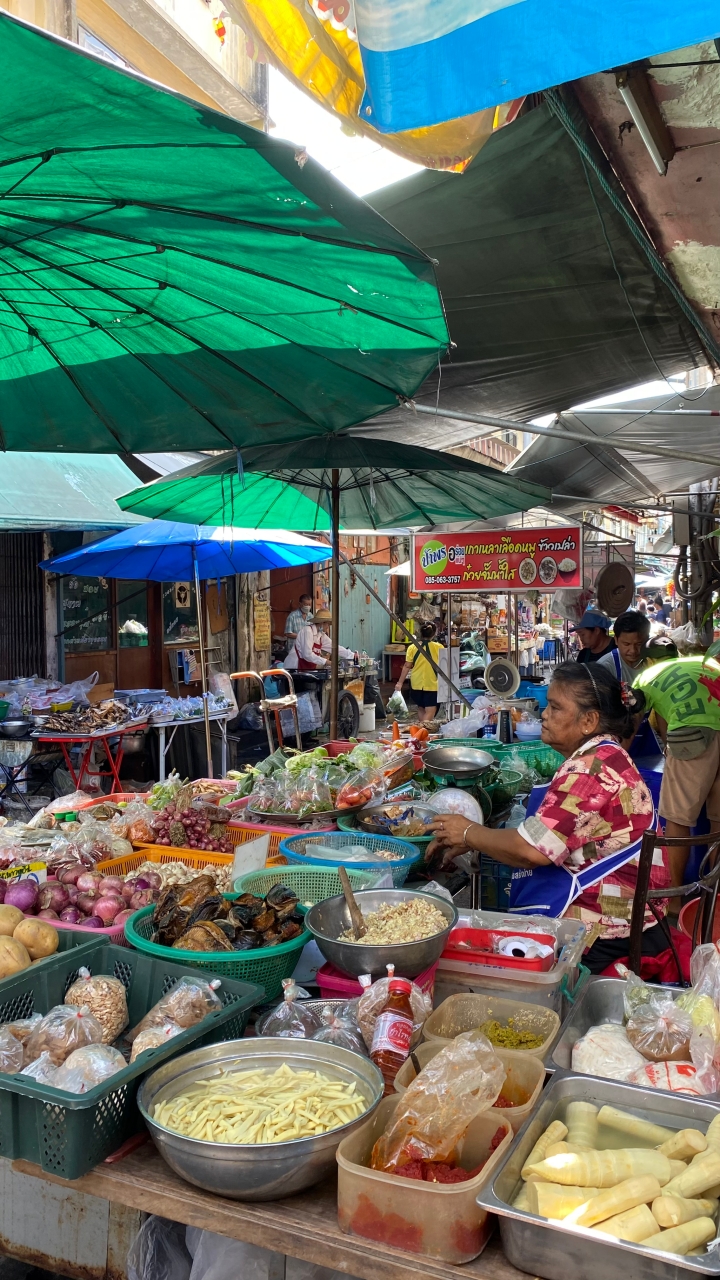
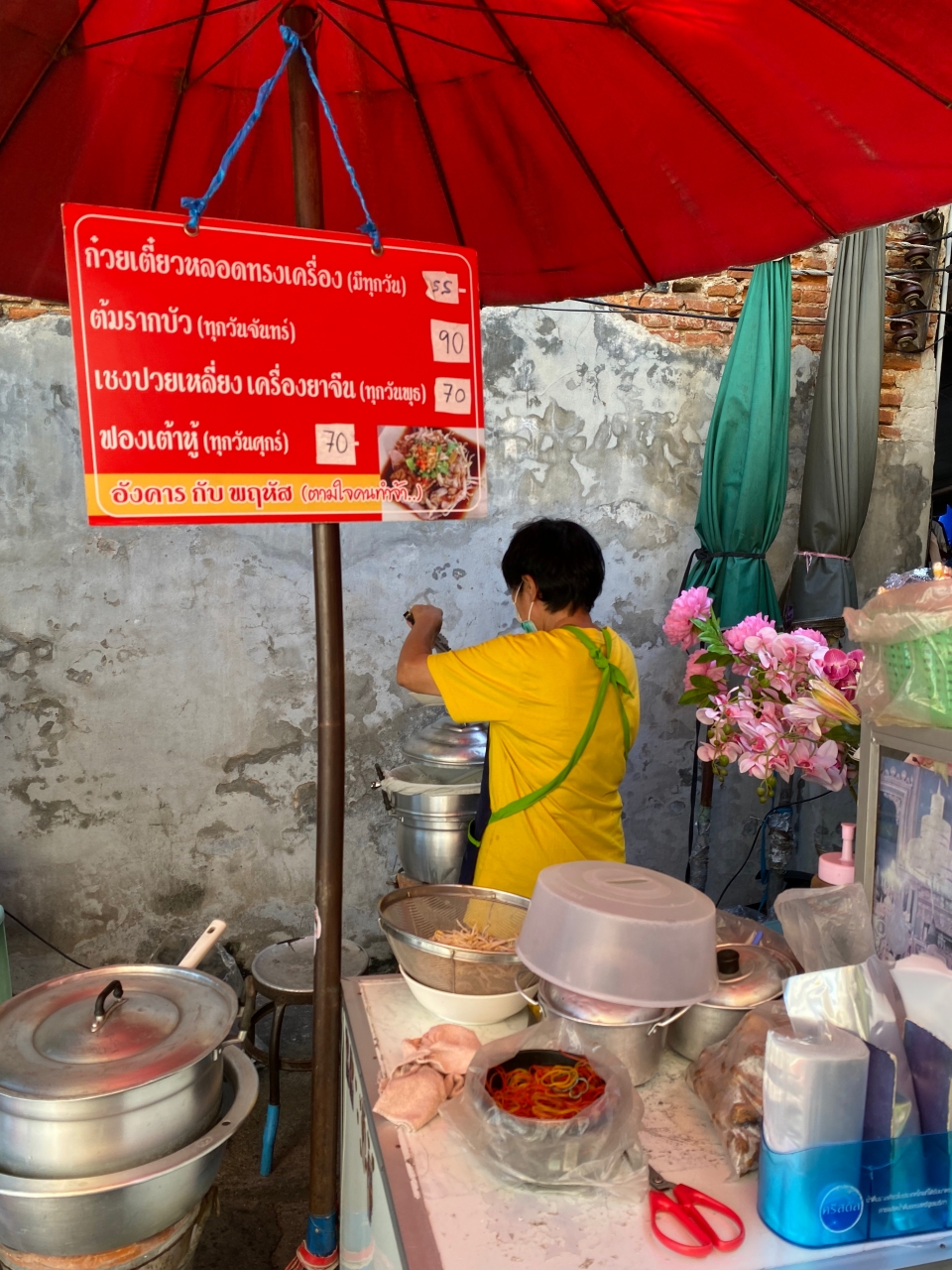
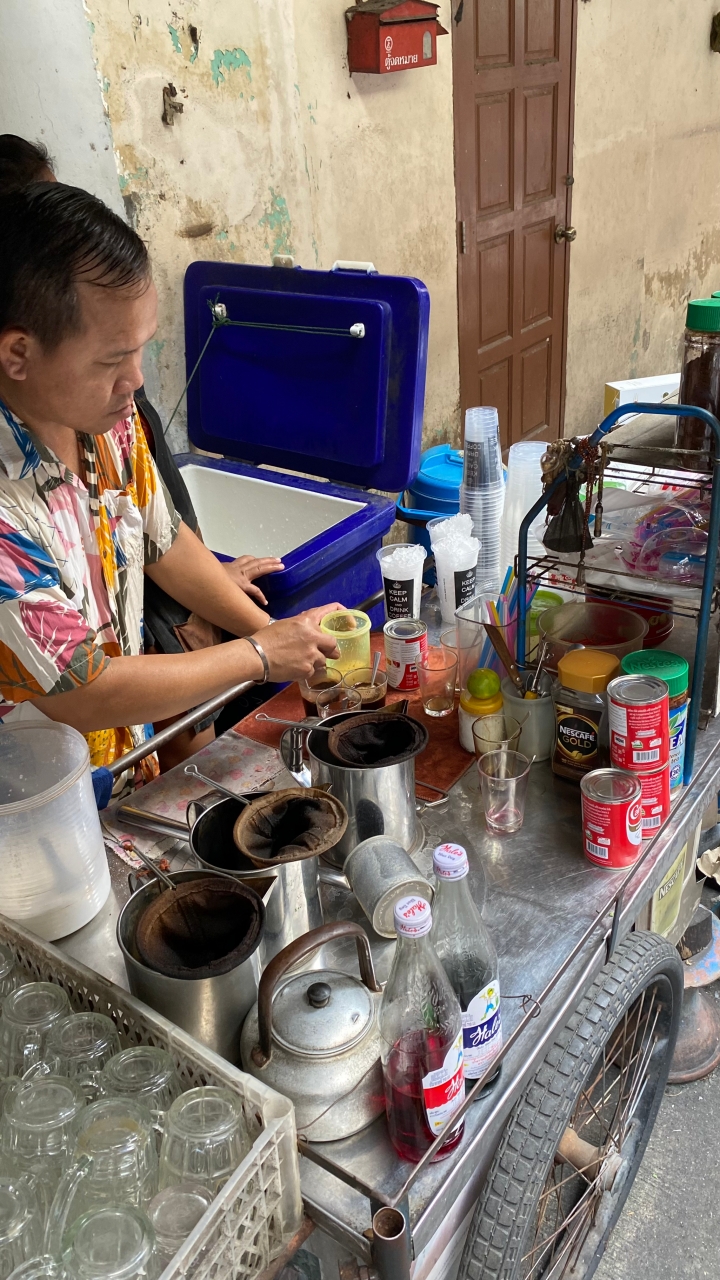

งั้นเรามาดูร้านที่เราอยากแนะนําที่สุดกัน! ร้านแรกกับร้าน “ป้าณี” ร้านคุณป้าอยู่ตรงข้ามกับซอยเล็กๆที่มีศาลเจ้าพ่อ คุณป้าอยู่ที่นี่มาตั้งแต่กว่า 50 ปีแล้ว โดยเริ่มขายอาหารโดยเฉพาะอาหารใต้สูตรเด็ดจากบ้านเกิดคุณป้าที่สุราษฯ เริ่มตั้งแต่ 30 กว่าปีที่แล้ว อีกอย่างคือ เมนูป้าณีไม่เหมือนกันเลยซักวัน ก็บอกแล้วว่าแล้วแต่โชคของคนกิน!
อีกร้านคือ “ร้านก๋วยเตี๋ยวหลอดป้าวิลัย” โดยสาวเชื้อสายจีนกวางตุ้งจากย่านตลาดพลู ป้าวิลัยได้ย้ายมาอยู่ย่านนี้หลังจากแต่งงานและได้คิดสูตรก๋วยเตี๋ยวหลอดสูตรเด็ดขึ้นมาโดยยังใช้เตาถ่านทําก๋วยเตี๋ยวหลอดที่มีรสชาติเข้มข้นทุกวัน แต่ละวันจะมีเมนูพิเศษด้วย คือ ต้มรากบัวทุกวันจันทร์ เชงปวยเหลี่ยงยาจีนทุกวันพุธ ฟองเต้าหูทุกวันศุกร์ หรือลองถามคุณป้าเองได้เลย!
ร้านสุดท้าย คือ ร้านเต้าหู้ทอด ถั่วทอดและข้าวโพดทอดเจ้าดังย่านนี้ของ “คุณป้าหนุน” ที่ขายที่ปากซอยเทศาก่อนเข้าถนนบํารุงเมืองมากว่า 50 ปีแล้ว ตั้งแต่รุ่นคุณแม่และคุณยายของคุณป้าเองที่เป็นคนไทยเชื้อสายอินเดียชาวซิกข์ คุณป้าจะเตรียมของตั้งแต่ตี4 และเริ่มขายตั้งแต่ 6 โมงเช้า เราแนะนําให้มาเช้าหน่อย! แล้วอย่าลืมพูดคุยกับคุณป้านะ คุณป้าคุยสนุกมากเลยทีเดียว
Let's check out the shops we recommend! The first one is "Auntie Nee's shop," located across from the Shrines. She has been in this neighborhood dishing up southern delicacies for over half a century! She started serving delicious southern food recipes from her hometown in Surat Thani around 30 years ago. The menu also changes daily based on the luck of the person who gets to eat it, making each visit unique every time we pass by.
Another shop is "Aunt Wilai Lod Noodle Shop," run by a Cantonese-Thai woman from Talat Phlu area. She has moved to this neighborhood after her marriage, serving tasty rice noodle rolls ( Kuay tieaw lod song kreung) cooked on a brazier. The shop offers daily specials such as lotus root soup on Mondays, Cheng Pui Liang's Chinese medicine on Wednesdays, and tofu foam on Fridays. You can also try asking Auntie by yourself!
The last one is a popular fried tofu shop that also sells fried beans and fried corn. "Auntie Nun" has been selling them at the entrance of Soi Thesa before entering Bamrungmuang Road for over 50 years since the times of her grandmother and mother who are of Thai descent of Indian Sikhs. She starts preparing everything from 4 AM, with sales starting at 6 AM. Therefore, we recommend coming early! And don't forget to talk to the aunt as she is a very fun person to talk to.
Contributed by
The Roots Routes
Cultural Experience Design Studio ที่เชื่อมโยงนักเดินทางกับชุมชนท้องถิ่น โดยการเล่าเรื่อง และให้ความเข้าใจในองค์ประกอบทางวัฒนธรรม ผ่านกระบวนการออกแบบ
A cultural experience design studio connecting travelers with local communities, emphasizing storytelling, and cultural immersion through the design process.
Chi Kat Cha
สัมผัสร่องรอยวัฒนธรรมและร่วมเรียนรู้ประวัติความเป็นมาของสามแพร่งที่ร้านกาแฟคู่ย่าน
Touching upon cultural echoes and the lore of the "Sam Phraeng" neighborhoods at a local coffee shop
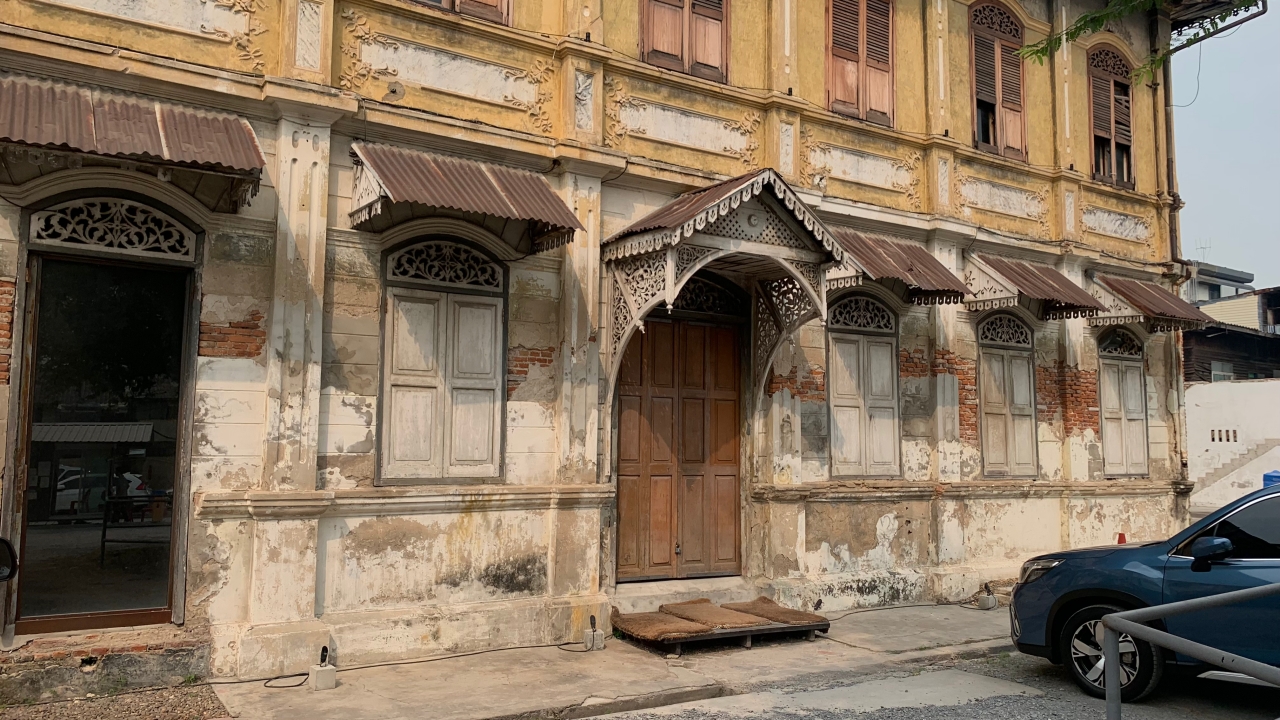
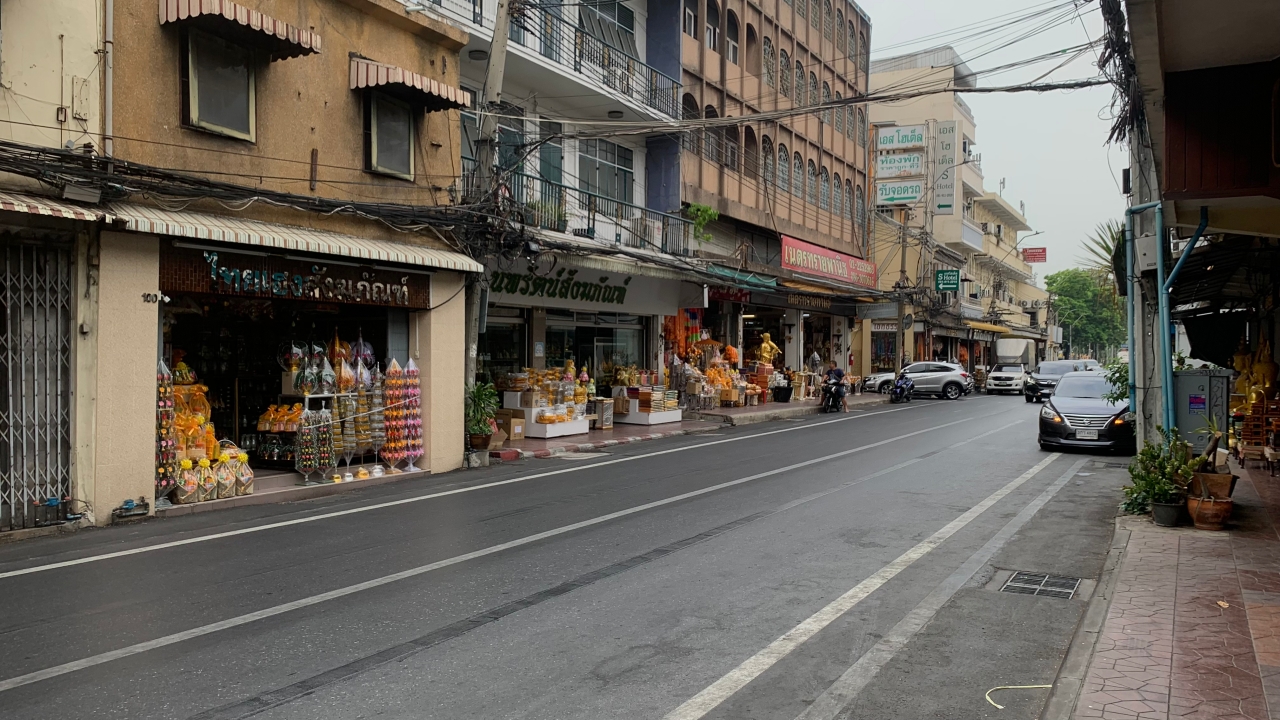
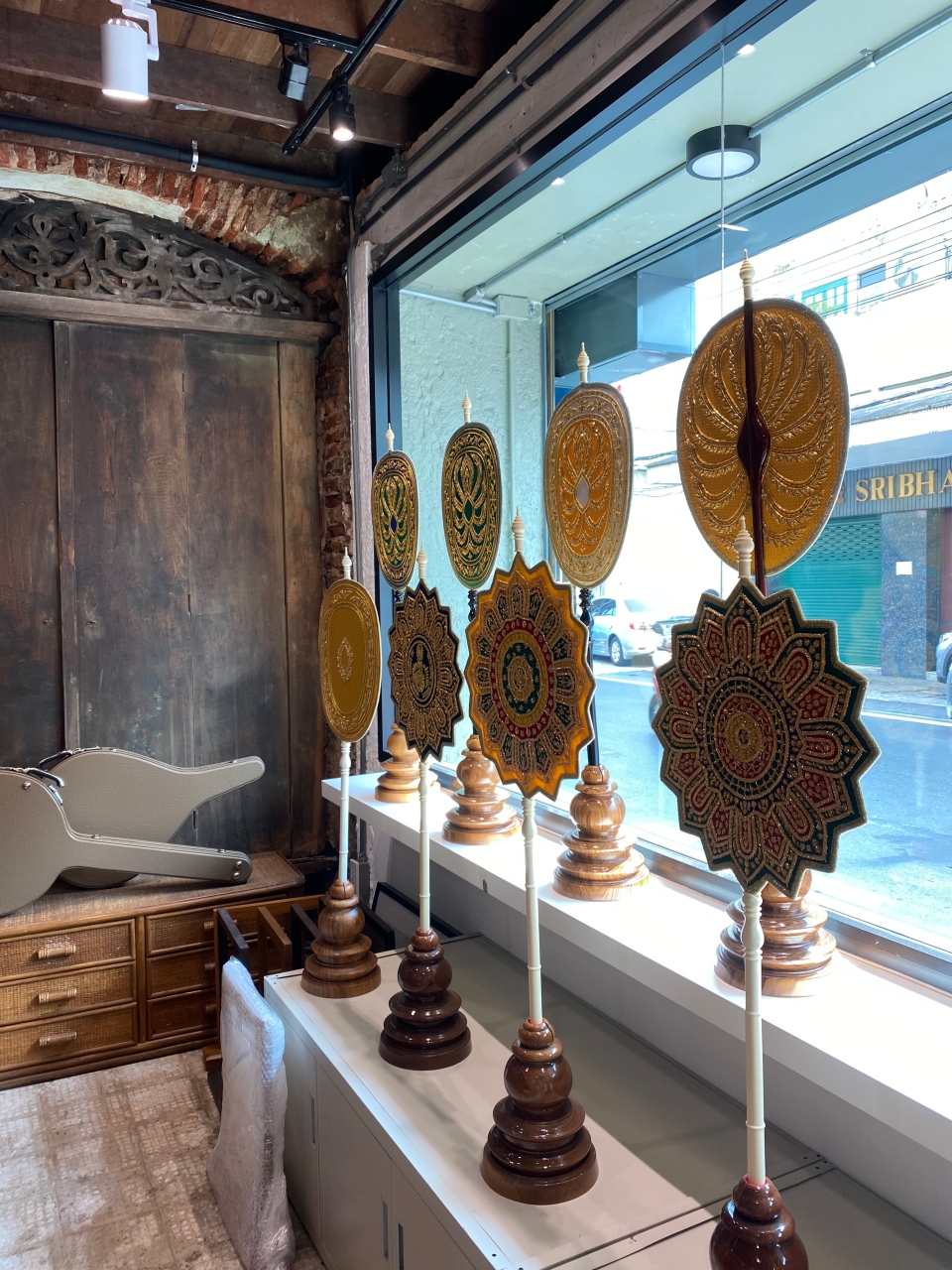
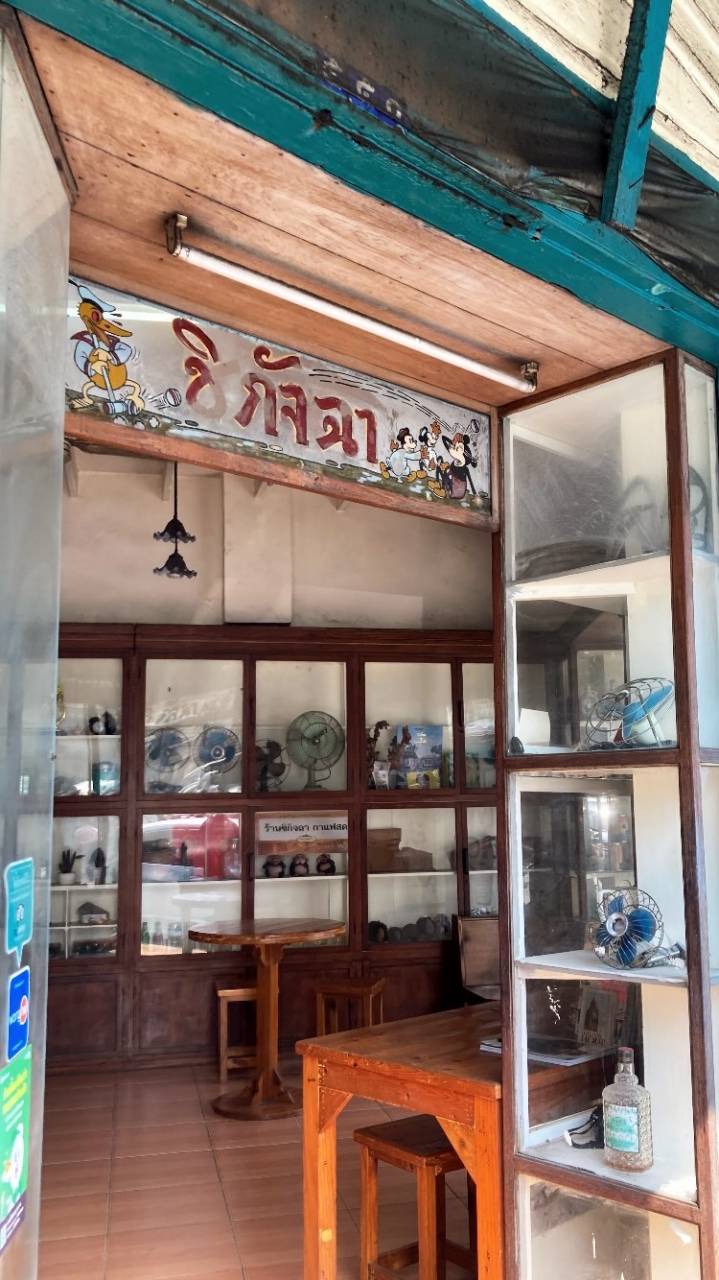

Walking Path Overview
เส้นทางนี้จะพาคุณไปทําความรู้จักกับสถานที่ต่าง ๆ ระหว่างเดินทางไปยังย่านสามแพร่ง และลิ้มลองรสชาติดั้งเดิมของเครื่องดื่มจากคาเฟ่เก่าแก่ที่เปิดมานานกว่า 3 รุ่น
This route will take you across various spots along the way to "Sam Phraeng" neighborhoods and savor authentic flavor of Thai drinks from a quaint café that has lived through 3 generations.
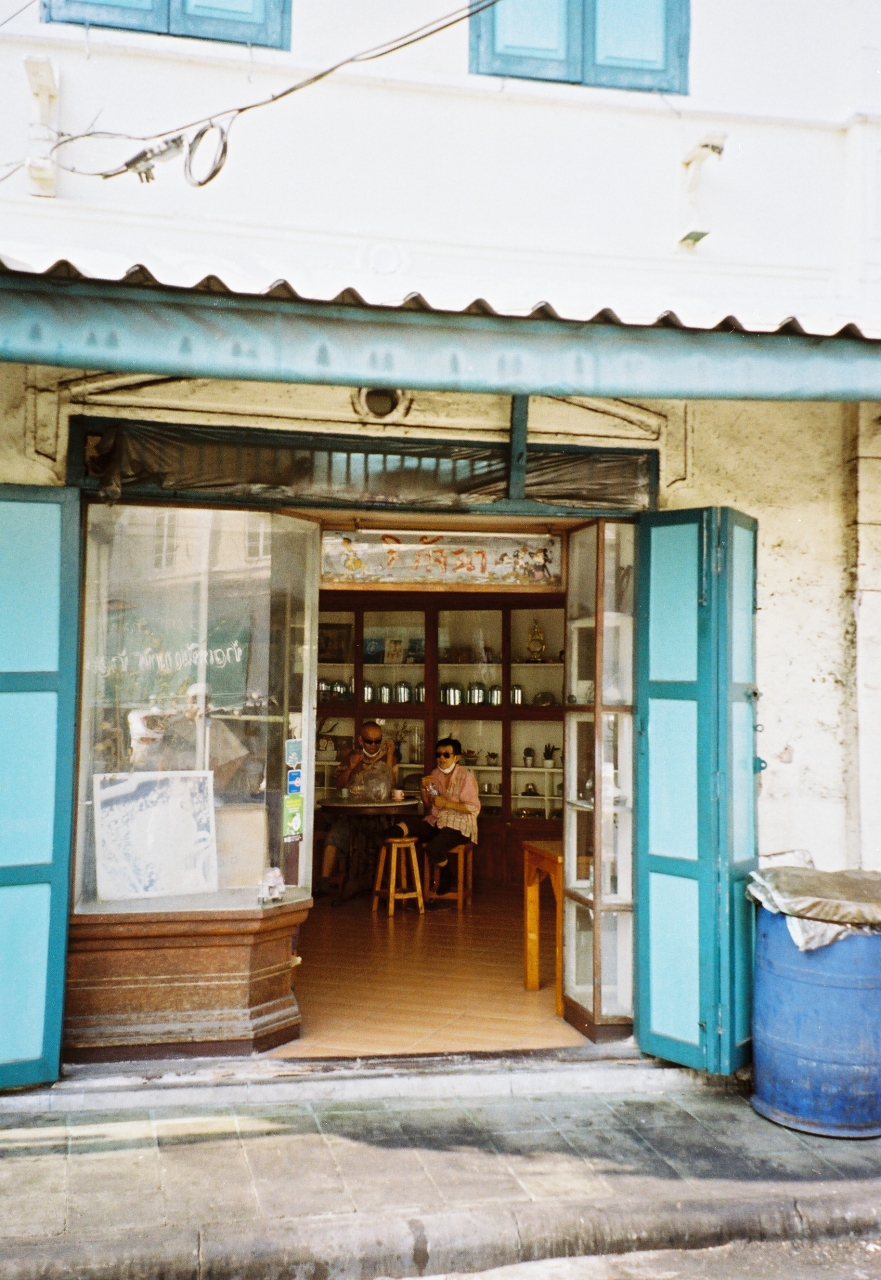

ร้านกาแฟโบราณ ณ ใจกลางย่านของอร่อยสุดขลัง
An old-school café in the heart of delicious vibrancy
บริเวณสามแพร่ง ซึ่งประกอบไปด้วย แพร่งภูธร แพร่งนรา และ แพร่งสรรพศาสตร์ ถือว่าเป็นแหล่งท่องเที่ยวที่มีความนิยมอย่างมากในย่าน Bangkok Old Town ท่ามกลางความเจริญของย่านนี้ แต่เดิมเคยถูกใช้เป็นเส้นทางสัญจรหลักทางคลองมาก่อน ทําให้มีการเข้าถึงและการลงหลักปักฐานของผู้คนเป็นจํานวนมากนั่นเอง
The Sam Phraeng neighborhoods comprise Phraeng Phuthorn, Phraeng Nara, and Phraeng Sapphasart, all standing among some of the most popular tourist destinations in the Bangkok Old Town area. Amidst the prosperity, the land of Sam Phraeng traces back to the days when it was once a main canal thoroughfare. This chapter of history led to widespread accessibility and a surge in the number of people settling across the area.
ในระหว่างทางเดินไปสามแพร่งนั้น คุณจะรายล้อมไปด้วยร้านค้ามากมายที่ขายสินค้าที่เกี่ยวข้องกับพุทธศาสนาตลอดทั้งสองข้างของถนน ชุมชนในพื้นที่นี้ได้ขายสินค้าจำพวกนี้ต่อเนื่องกันมานานกว่า 100 ปีแล้ว ซึ่งเจ้าของร้านส่วนใหญ่ก็เป็นชาวไทยเชื้อสายจีน ซึ่งสามารถสังเกตได้จากป้ายร้านที่มักใช้ชื่อจีนกันนั่นเอง
นอกจากนี้คุณจะพบกับโรงพิมพ์เก่าในซอยลับแห่งหนึ่ง ชื่อว่า “โรงพิมพ์บํารุงนุกูลกิจ” ที่ถูกก่อตั้งขึ้นในสมัยรัชกาลที่ 5 ซึ่งถือว่าเป็นโรงพิมพ์ที่ทันสมัยมากในช่วงเวลานั้น โรงพิมพ์นี้ใช้เครื่องพิมพ์ระบบน้ํามันและเคยจ้างพนักงานถึง 70-80 คนเลยทีเดียว ความจริงแล้วเคยมีโรงพิมพ์แห่งที่สองอยู่ใกล้เคียงด้วยเช่นกัน แต่เนื่องจากเกิดไฟไหม้ครั้งใหญ่ราวปี พ.ศ. 2494 ส่งผลให้อุปกรณ์การพิมพ์เสียหายจํานวนมากจนต้องปิดไปในที่สุด
สองจุดสุดท้ายก่อนถึงสามแพร่ง คือ ร้านพัดยศที่เปิดมานานถึงสามรุ่น โดยคุณบอย เจ้าของรุ่นปัจจุบัน เล่าว่า พัดที่นี่มีดีไซน์และสีที่แตกต่างกัน เพื่อใช้ในวัตถุประสงค์ต่าง ๆ กัน เช่น พิธีกรรมทางศาสนาถึงงานพระราชพิธี และยังคงทําด้วยมืออย่างประณีตทุกใบ ถึงแม้ร้านจะมีอายุกว่า 80 ปีแล้ว แต่ก็เพิ่งปรับปรุงและจัดแสดงพัดสวยๆ ให้เราได้ชมเมื่อไม่นานมานี้เอง ส่วนตรงข้ามถนนแยกสี่กั๊กเสาชิงช้า ตรงหัวโค้งก็จะเห็นร้านน้ําชา “ใบชาอ๋องอิวกี่” ซึ่งเป็นผู้นําเข้าชารายใหญ่ที่สุดในพระนครตั้งแต่ปลายสมัยรัชกาลที่ 5 เมื่อปี 2450 และมีชาหลากหลายประเภทตั้งแต่ชาจีนถึงชาไทย ทุกวันนี้ร้านก็ยังคงขายชาอยู่ในราคาที่เอื้อมถึงและขายชาสูตรพิเศษของทางร้านด้วย
On the way to Sam Phraeng, both sides of the street will be occupied by numerous shops that sell a variety of Buddhism-related products. The communities here have been continuously selling these items for up to 100 years. The majority of shop owners are also of Thai-Chinese descent, as can be noticed from the display of Chinese names on their shop signs.
Besides, you may encounter an old printing house tucked away in a hidden alley, known as “Bamrung Nukunkit Print Shop.” Constructed during the reign of King Rama V, this printing house is considered highly modern for its time, using an oil-based printing system and employing up to 70-80 workers. In fact, there was once a second printing house nearby. Unfortunately, due to a major fire around 1951, a massive amount of printing equipment was damaged, leading to its eventual closure.
One of the last two spots before arriving at Sam Phraeng is a "Phad Yod (Fan of Rank)" shop that has been open for three generations. The current owner, Mr.Boy, shares that the fans here have different designs and colors, each serving various purposes from religious ceremonies to royal rituals and every pieces are all delicately made by hands. While the shop has been around for over 80 years, it has recently been renovated and arranged beautiful fans for us to see. Just across the street, you will also find the tea shop named "Bai Cha Ong Kiw Ki," the largest tea importer in Bangkok since the reign of King Rama V since 1907. Here, they offer a diverse kind of teas, ranging from Chinese to Thai, as well as their special blends, and still continue to sell tea at affordable prices until today.
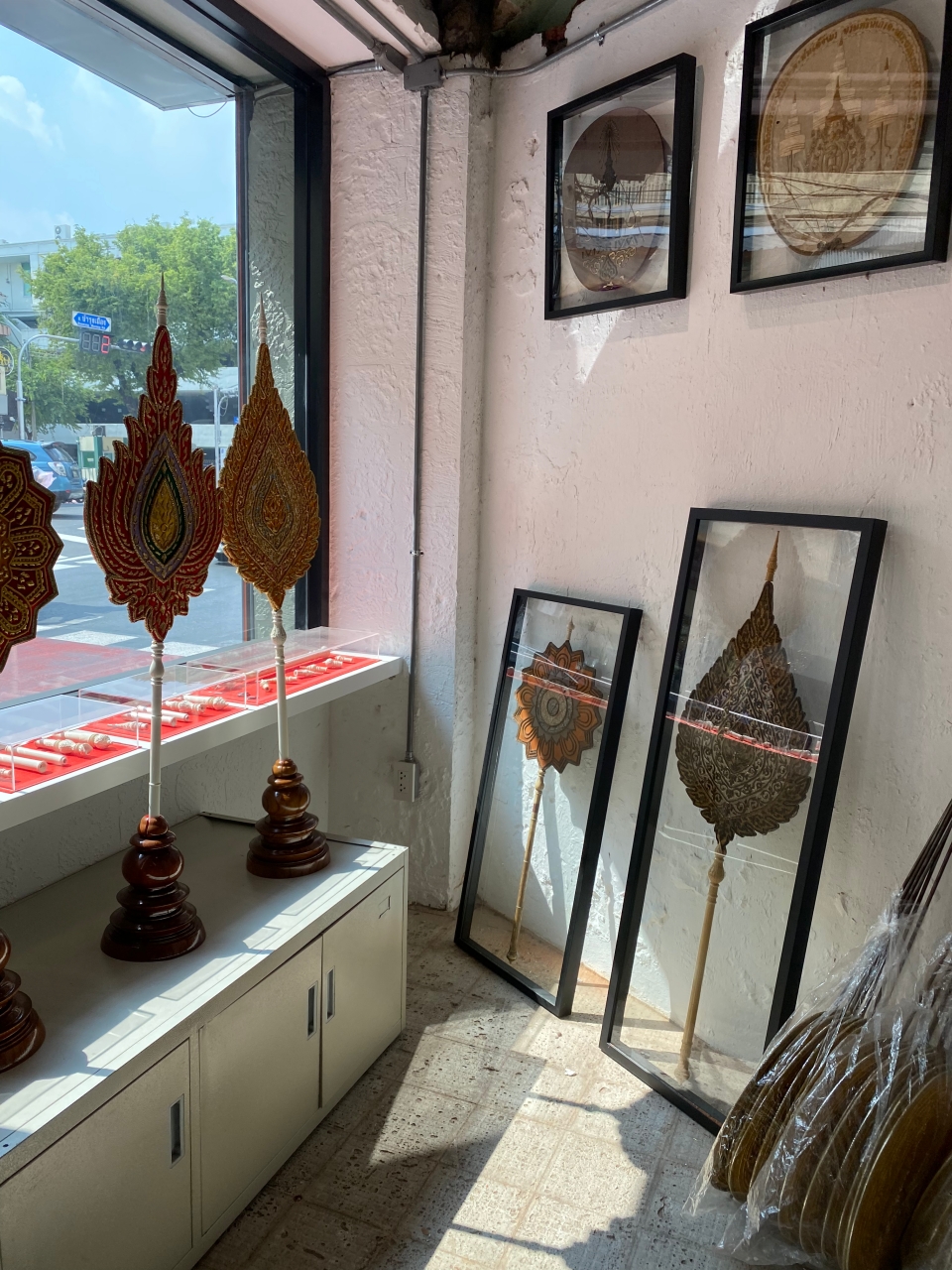


และเราก็่มาถึงย่านสามแพร่ง สามแพร่งเริ่มต้นขึ้นเมื่อสมัยปี พ.ศ. 2310 หรือในช่วงที่สมเด็จพระเจ้าตากสินย้ายเมืองหลวงมาที่ธนบุรี ตามพงศาวดารบริเวณนี้เคยถูกเรียกว่า "ทะเลตม" ซึ่งหมายถึงที่ราบลุ่มขนาดใหญ่ที่มีน้ําขังตลอดปี ทำให้ในอดีตพื้นที่ตรงนี้ถูกใช้ทั้งในการตั้งค่ายรบและปลูกข้าวเพื่อผลิตเสบียง
ต่อมาในสมัยรัชกาลที่ 1 กรุงเทพถูกสร้างขึ้น ทําให้มีการขุดคูเมืองและกําแพงเมืองเพิ่ม บวกกับทําเลที่ตั้งที่ใกล้พระบรมมหาราชวัง คลองรอบกรุงและคลองหลอด ซึ่งเป็นเส้นทางสายหลักในอดีต ทําให้มีทั้งเชื้อพระวงศ์ ข้าราชการ และชาวบ้านย้ายเข้ามาปักหลักบริเวณนี้เป็นจํานวนมาก โดยเฉพาะปากคลองคูเมือง ที่มีทั้งวังเจ้านาย บ้านข้าราชการเสนาบดีและประชาชนอยู่กันเต็มไปหมด
Here we are at Sam Phraeng neighborhood. Sam Phraeng has its roots dating back to 1767 when King Taksin moved the capital to Thonburi. According to the annals, this area was formerly referred to as "Muddy Sea," meaning a large plain with stagnant water throughout the year. That’s why in the past, this area was used for military camps and rice cultivation.
Later in the reign of King Rama I in 1782, Bangkok was established. City moats and walls across the land were increasingly excavated. Combined with its location near the Grand Palace, city canals, and Lod canals, which were the main transportation routes in earlier days, this area transformed into a hub for royal descendants, government officials, and all local residents settling here.
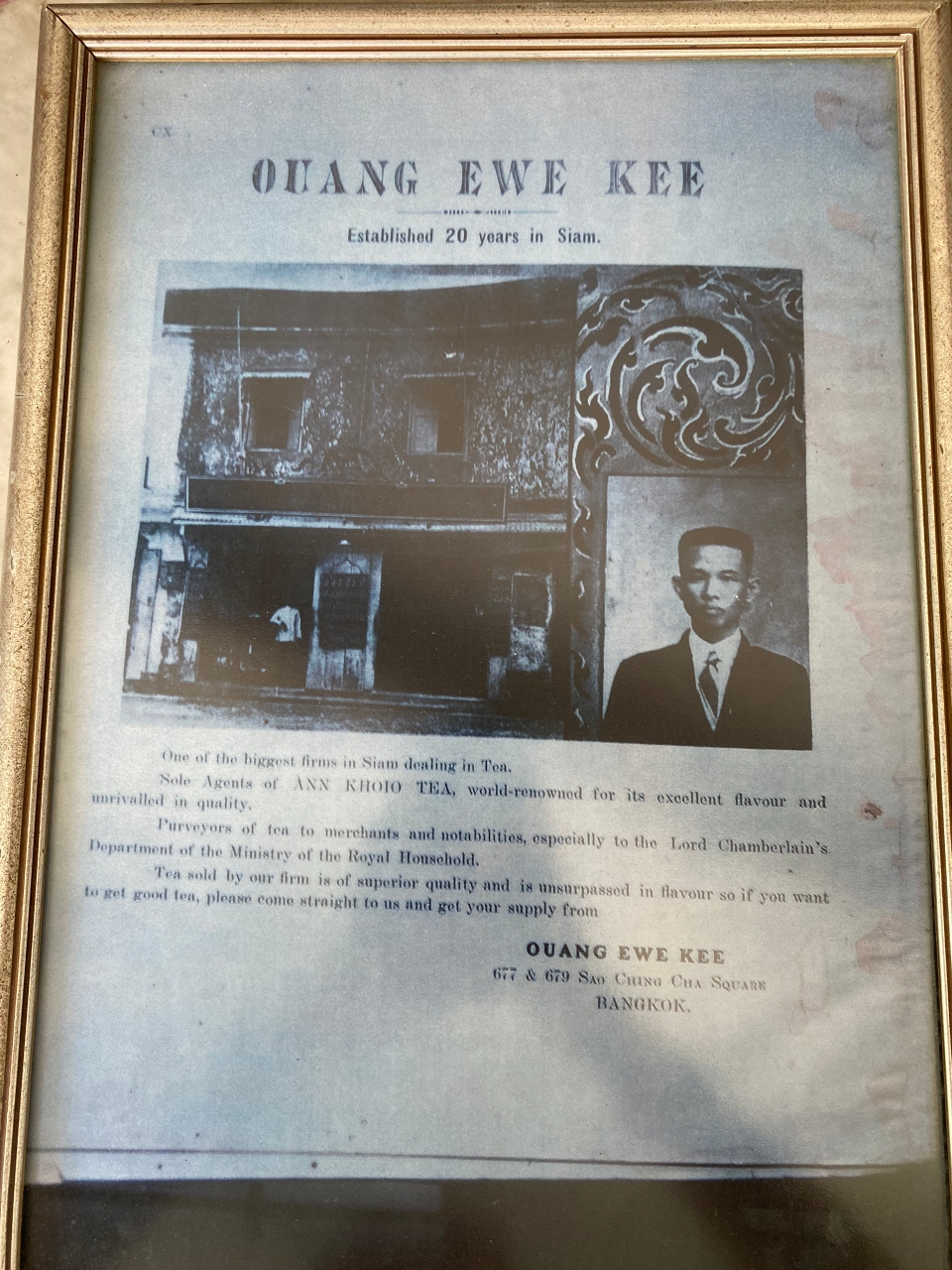

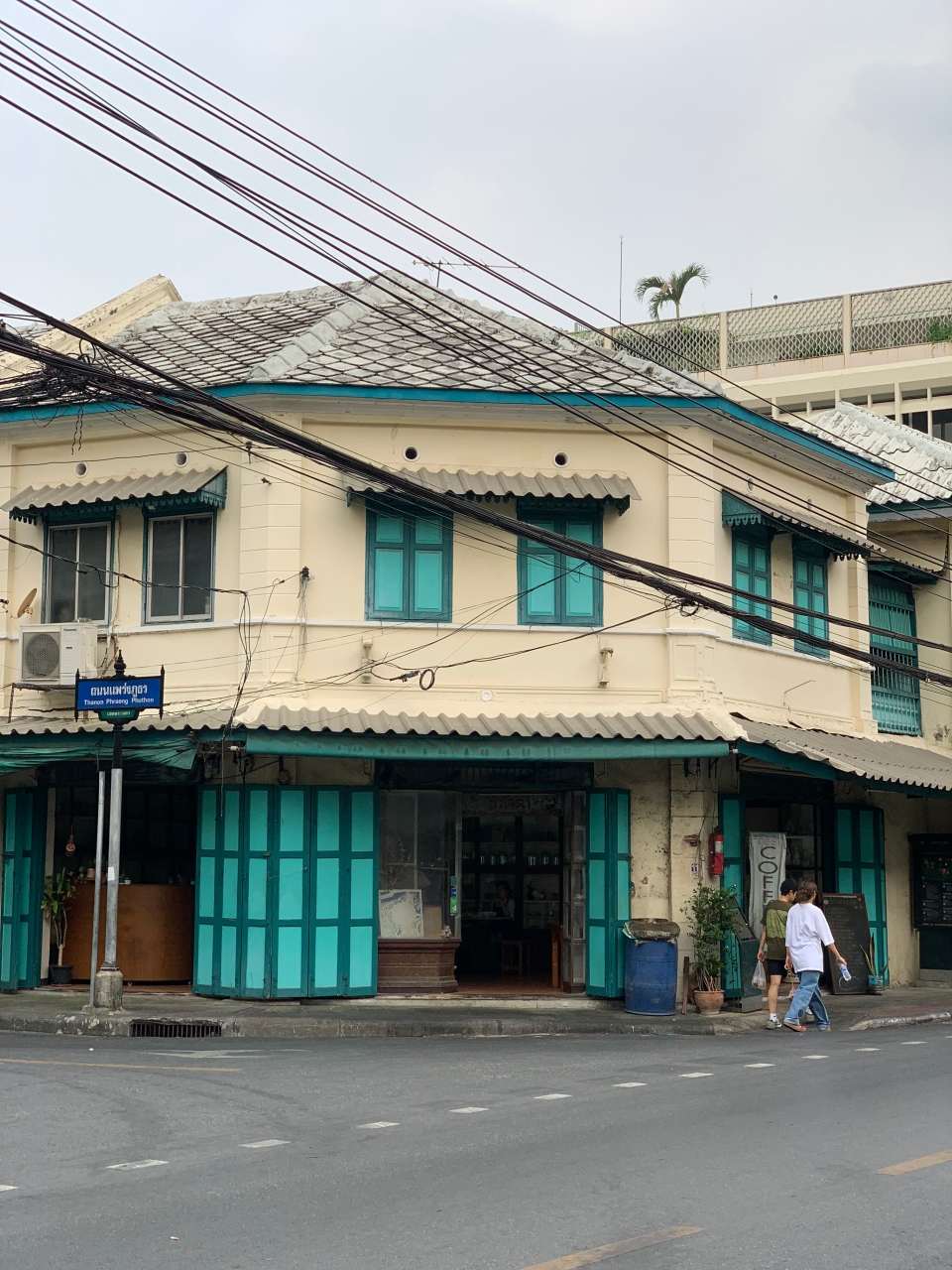
ในระหว่างรัชกาลต่อ ๆ มา ย่านสามแพร่งได้รับการพัฒนามากมาย สังเกตได้จากสมัยปัจจุบันที่ยังเหลือร่องรอยของอาคารเก่าสวย ๆ อยู่หลากหลายแห่ง หนึ่งในนั้นคือผลพวงมาจากการพัฒนาพื้นที่ตั้งแต่สมัยรัชกาลที่ 4 ที่ทําสัญญากับชาติตะวันตก บวกกับที่ตั้งใกล้วังหลวง ทําให้ร้านค้าต่าง ๆ รวมไปถึงบริษัทต่างชาติเข้ามาอยู่กันเป็นจํานวนมาก อย่างเช่น ร้านชาอ๋องอิวกี่ ร้านชาที่นําเข้าชาจีนแห่งแรกในไทยที่เราเพิ่งเดินผ่านกันไป ต่อมาในสมัยรัชกาลที่ 5 ก็มีการเปลี่ยนจากพื้นที่อยู่อาศัยเป็นที่ตั้งของกระทรวงต่าง ๆ ทําให้มีร้านค้าเพิ่มขึ้นอีกเพื่อตอบสนองความต้องการของข้าราชการที่ทํางานในกระทรวง
จนถึงทุกวันนี้ สามแพร่งยังคงความเป็นย่านการค้า เป็นย่านของอร่อยสําหรับคนที่ทํางานราชการและชาวท้องถิ่นละแวกนี้ หนึ่งในร้านที่ห้ามพลาดเลยในแพร่งแรก คือ แพร่งภูธรนั่นคือ ร้านชิกัจฉาของพี่หมู ซึ่งเป็นร้านกาแฟเก่าแก่ที่ขายมานานกว่าสามรุ่น เราอยากแนะนำให้อย่าลืมสั่งชาไทยซีลอนและโรตีของพี่หมูมาลองชิมกันดูด้วย หรือจะเป็นไอศครีมนัฐพร ไอศครีมโฮมเมดแบบไทย ๆ ที่มีชื่อเสียงต่อเนื่องมานานกว่า 70 ปีแล้วนั่นเอง
Over the following reigns, Sam Phraeng underwent significant development, as witnessed in the present-day remnants of several beautiful old buildings. One important factor is the land development since in the mid-19 century or in the reign of King Rama IV, which entered into treaty with Western nations. Plus its proximity to the Grand Palace, this area subsequently attracted a number of businesses, especially international companies. For instance, a place that we just walked by, the renowned "Ong Kiw Ki" tea shop was the first branch to import Chinese tea into Thailand. Later, during the Victorian era in King Rama V’s times, residential areas were transfigured into the locations of various ministries, capable of drawing more foreign companies and businesses to suit the needs of government officials working in the ministries.
Until today, Sam Phraeng neighborhoods continue to thrive as a commercial and culinary district, catering to government workers and locals living in this vicinity. One of the must-visit spots feature P’Muu’s "Chi Kat Cha, " a vintage and long-standing cafe that has been serving customers for over three generations. Here, we would like to recommend you to try her Ceylon Thai Tea and Roti! Or you could also walk to "Natthaphon ice cream" nearby, which offers a traditional Thai homemade ice cream with a renowned reputation for over 70 years.
Contributed by
The Roots Routes
Cultural Experience Design Studio ที่เชื่อมโยงนักเดินทางกับชุมชนท้องถิ่น โดยการเล่าเรื่อง และให้ความเข้าใจในองค์ประกอบทางวัฒนธรรม ผ่านกระบวนการออกแบบ
A cultural experience design studio connecting travelers with local communities, emphasizing storytelling, and cultural immersion through the design process.
P.Space
ร่วมสำรวจพื้นที่ชุมชนเพื่อการอนุรักษ์และสร้างสรรค์ที่จะทําให้ประสบการณ์การเที่ยวในชุมชนท้องถิ่นไม่เหมือนเดิม
Unfolding a community space for conservation and creativity, one that makes your local travel experiences like no other
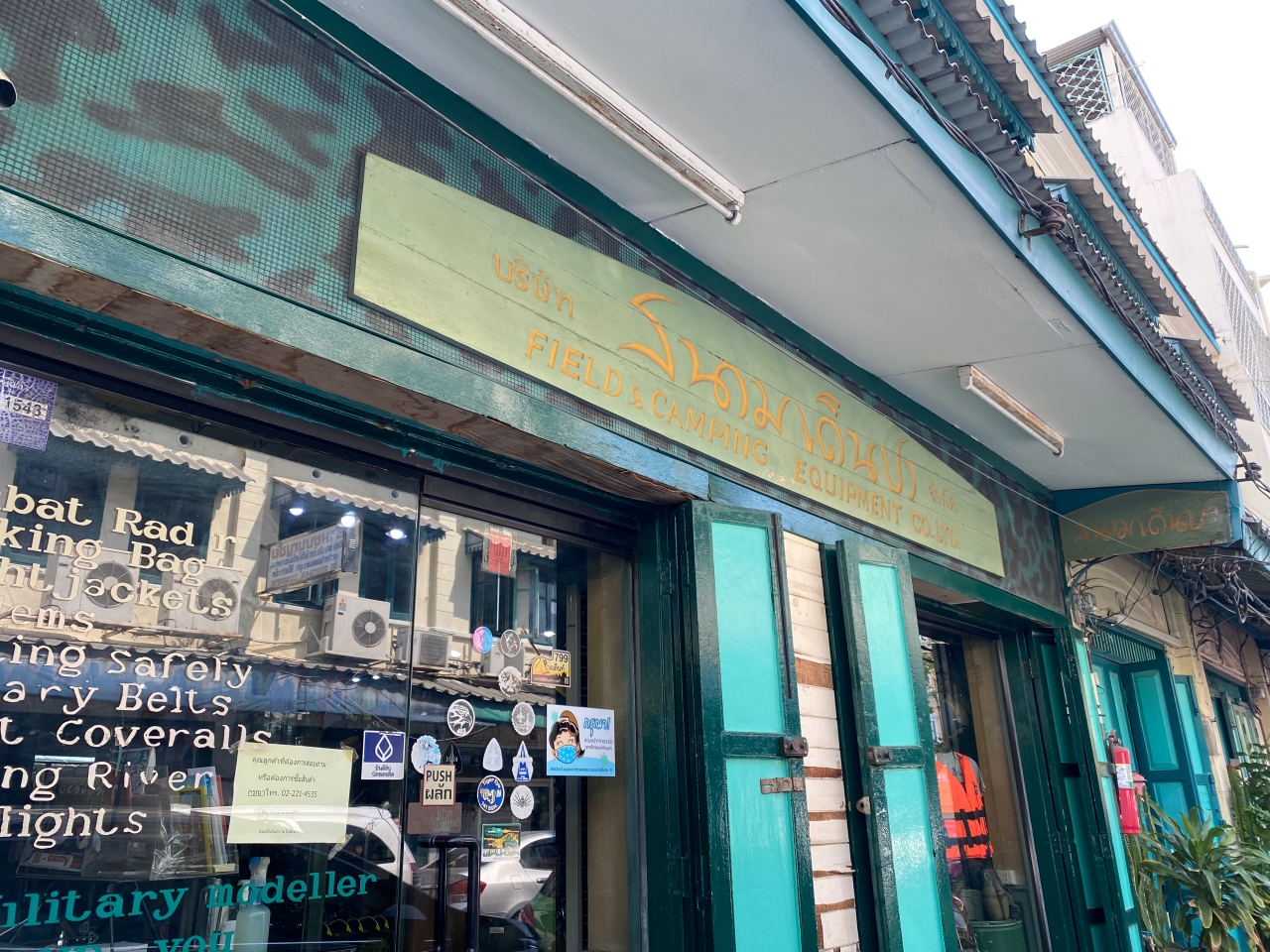

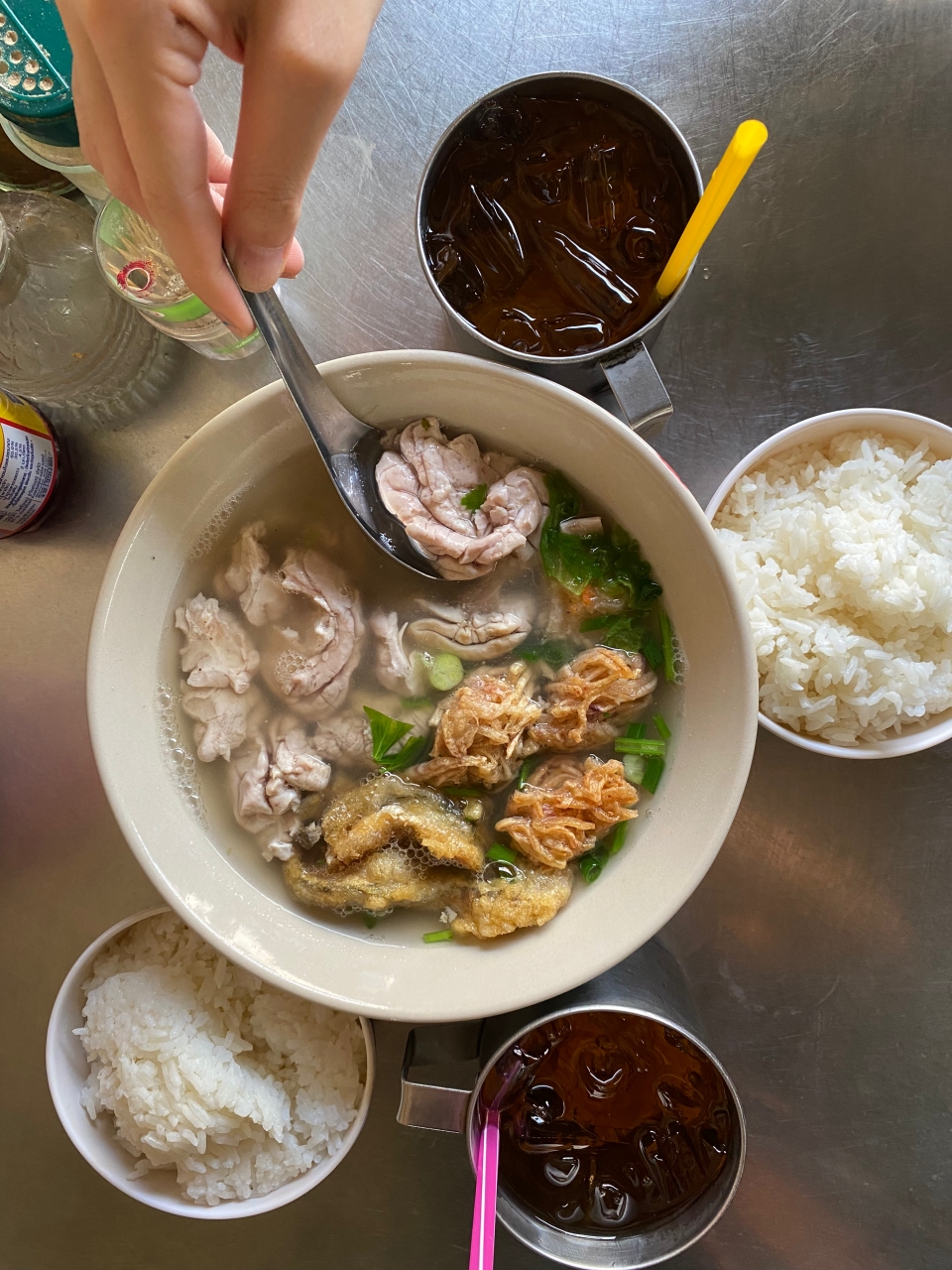

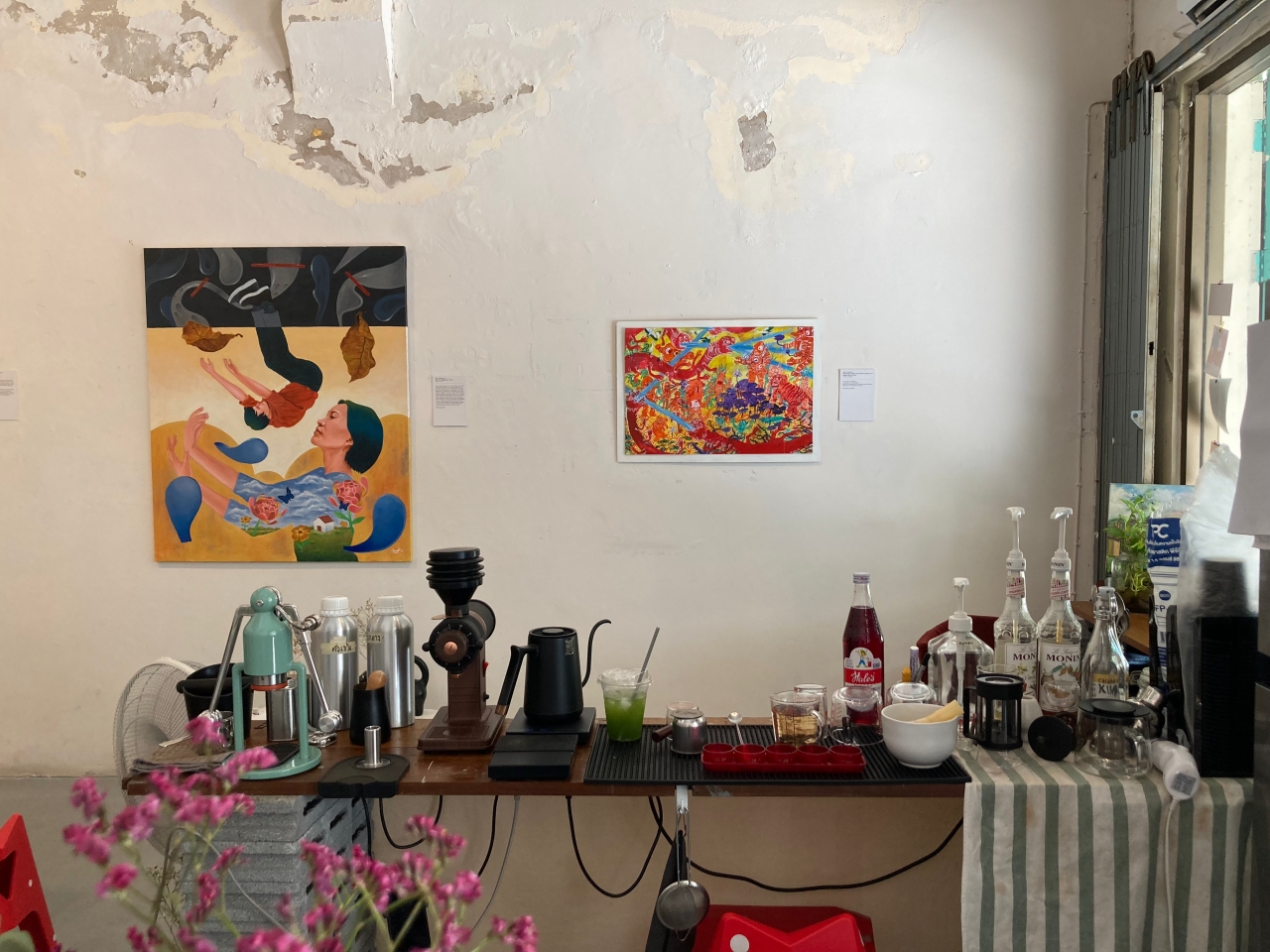
Walking Path Overview
ในจุดหมายนี้เราจะพาคุณไปพบกับอาร์ตแกลลอรีสุดฮิป พร้อมชวนคุณสํารวจแพร่งภูธรและแพร่งนราที่เต็มเปี่ยมไปด้วยเรื่องเล่าที่คุณอาจจะไม่เคยรู้มาก่อน
This destination will guide you to a hip art gallery while inviting you to explore the charm of Phraeng Puthorn and Phraeng Nara through its packed narratives that may unroll stories you’ve yet to discover.


เชื่อมโยงชุมชนอย่างสร้างสรรค์ด้วย “Heritage Habitats”
Bringing communities for a creative get-together with “Heritage Habitats”
จุดแรกของเราคือ แพร่งภูธร ซึ่งถูกเรียกกันมาจากพระนามของ พระองค์เจ้าบรมวงศ์เธอกรมหมื่นภูธเรศธํารงศักดิ์ ซึ่งเป็นพระราชโอรสของรัชกาลที่ 4 และพระอนุชาของรัชกาลที่ 5 ผู้ได้ปรับปรุงบริเวณนี้ แต่เดิมเคยเป็นวังที่มีชื่อว่า "วังสะพานช้างโรงสี" ในสมัยรัชกาลที่ 2 เมื่อครั้นบริเวณนี้ยังเป็นบริเวณวังของเชื้อพระวงศ์ ต่อมาเมื่อพื้นที่ตรงนี้ได้ถูกส่งต่อมาเป็นทอด ๆ จนถึงสมัยพระองค์ท่าน เมื่อพระองค์ท่านสิ้นพระชนม์ รัชกาลที่5 ทรงซื้อพื้นที่ต่อและได้รื้อถอนอาคารต่าง ๆในวังและสร้างตึกแถวสไตล์ตะวันตกตามแบบฝรั่งเศสขึ้นมาแทน รวมถึงมีการออกแบบให้มีพื้นที่ว่างตรงกลาง หรือ คอร์ท court ที่เราเห็นในปัจจุบันนั่นเอง สุดท้ายจึงกลายมาเป็นชื่อย่าน “แพร่งภูธร” อย่างที่เราเรียกกันในปัจจุบัน
Our starting point is Phraeng Phuthon, a neighborhood named after His Royal Highness Prince Phutharetdhamrongsuk, the son of King Rama IV and the brother of King Rama V, who renovated this area. Formerly, this land around here was titled "Saphan Chang Rong See Palace" during the reign of King Rama II when it was still part of the royal compound. This area was passed down under royal ownership until his period. Later, following his passing, King Rama V acquired the land and demolished existing structures, replacing various palace buildings with French-style shophouses. He also designed a communal courtyard or court in the center, just as we see today. Eventually, this area evolved into the present-day district known as "Phraeng Phuthorn."
มีร้านที่เราอยากแนะนำในแพร่งภูธรอยู่บ้าง ร้านแรกคือ ร้านเสรี ที่เปิดมานานแล้ว คุณสามารถลองชิมอาหารรสชาติอาหารแบบดั้งเดิมได้ที่นี่รวมถึงเมนูเด็ดของที่นี่ที่เราชอบคือ เมนูทอดกระเทียม! และถ้าเห็นบริเวณตรงกลางพื้นที่ในอดีตยังถูกสร้างเป็น "สุขุมาลอนามัย" ที่เป็นสถานอนามัยที่สร้างเพื่อเป็นอนุสรณ์ให้กับพระปิตุจฉาเจ้าสุขุมาลมารศรีอีกด้วย ปัจจุบันนี้ก็ยังเปิดบริการอยู่สําหรับชุมชนด้วย
ก่อนจะถึงแพร่งนรา อีกหนึ่งจุดแวะที่เราอยากแนะนําคือ ร้านเกาเหลาสมองหมูไทยทําแห่งแพร่งภูธร อีกหนึ่งตํานานความอร่อยกว่า 60 ปี ความจริงแล้วชื่อร้าน “ไทยทํา” มาจากว่าจริง ๆ แล้วอาหารชนิดนี้เป็นสูตรจีนแคะที่คุณย่าสุดจิตต์ เจ้าของร้านได้พัฒนาสูตรที่ส่งต่อจากคุณแม่บุญธรรมชาวจีนมาเป็นสูตรลับความอร่อยของตัวเอง ชื่อร้านเลยหมายถึงอาหารจีนที่ทําโดยคนไทยนั่นเอง
ระหว่างทางไปแพร่งนรา คุณจะพบกับร้านขายของเดินป่าและเครื่องแบบทหารอยู่มากมาย นั่นเพราะว่าที่นี่ตั้งอยู่บริเวณหลังกระทรวงกลาโหมนั่นเอง และถ้าเดินไปเรื่อย ๆ ก็จะเห็นร้านขายเครื่องดนตรีที่ขายกันมาหลายสิบปีแล้วด้วย เมื่อเดินต่อไปยังแพร่งนรา ตลอดสองข้างถนนระหว่างทางไป P.Space ก็จะมีร้านค้าเรียงรายอยู่ บางบ้านก็เป็นร้านงานโลหะและช่างรับชุบทองลงยา ซ่อมแซม ยศเครื่องหมายหรือเครื่องราชฯ หรือจะยังมีร้านเครื่องประดับให้ลองเลือกชมกันอีกด้วย
Before anything else, we want to recommend some spots featured in Phraeng Phuthorn. The first one is the long-history "Seri Thai Cuisine." Here, you can try traditional dishes with authentic flavors, including our go-to favorite, the fried garlic menu. If you look at the central area, this space was also built as a health center in the past, called "Sukhuman Anamai," created to pay homage to Princess Sukhumala Marasri. This center still serves the community as usual, even nowadays.
Before reaching Phraeng Nara, we invite you to make another delicious pitstop at Phraeng Phuthorn for the 60-year legendary “Thai-Tham Pork Brain Gao Lao Soup.” The shop’s name, "Thai Tham (Thai-made)," actually comes from the fact that every dish here is a Thai-style adaptation of a Chinese recipe handed down by the owner's grandmother, Sudjit. This becomes the reason why the name of the shop signifies Chinese food that is made with a unique Thai touch.
On the way to Phraeng Nara, you will discover several forest trekking shops and military-style equipment stalls, all because we are behind the Ministry of Defense. If you continue walking, you will find music instrument stores that have been in business for many decades. Heading towards Phraeng Nara, on both sides of the road close to P.Space, our destination, there will be shops featuring metalworking and gold-plating workshops. These artisans specialize in repairing and embellishing royal emblems and insignias. You can also venture further to explore any other jewelry stores nearby.



จากนั้นเราก็จะถึงที่ P.Space ที่ที่เกิดจากความตั้งใจที่จะสร้างพื้นที่เล็ก ๆให้ย่านแพร่งนรามีชีวิตชีวายิ่งขึ้น ซึ่งย่านนี้ถือเป็นแหล่งงานศิลปะมาตั้งแต่อดีตแล้ว จุดมุ่งหมายของแกลเลอรี่นี้คือ อยากส่งเสริมให้ศิลปะเป็นส่วนหนึ่งในชีวิตของผู้คนและชุมชน ผ่านกิจกรรมสร้างสรรค์ต่าง ๆ รวมถึงเปิดโอกาสให้ศิลปินรายย่อยได้แสดงผลงานของตัวเอง
ปัจจุบัน P.Space เปิดให้บริการหลายอย่าง เช่น เป็นพื้นที่สําหรับจัดนิทรรศการศิลปะและผลงาน ชั้นเรียนโยคะ ตลอดจนเวิร์คช็อปและกิจกรรมหลากหลายในละแวกนี้ ซึ่งสามารถเรียกได้ว่าเป็นหนึ่งในเครือข่าย "Heritage Habitat" เช่นกันที่สามารถต่อยอดความสร้างสรรค์ และการอนุรักษ์สถาปัตยกรรมแบบเก่าไว้ในคราวเดียวกัน
Then, we will arrive at P.Space, a place born from its visionary purpose—to nurture a small community area within the Phraeng Nara neighborhood and transform it into a vibrant hub that has long thrived as an artistic center. Through a variety of creative activities, P.Space’s mission is to promote art as an integral facet of people's lives and the local community. The place also becomes a welcoming avenue that expands opportunities for independent artists to showcase their work.
At the moment, P. Space offers a number of services, from being an exhibition space for artworks to hosting yoga classes, workshops, and many other activities in this vicinity. With its strong commitment, P.Space becomes one of the creative "Heritage Habitats" network, capable of creating a rich combination where creativity and the preservation of old architecture converge.
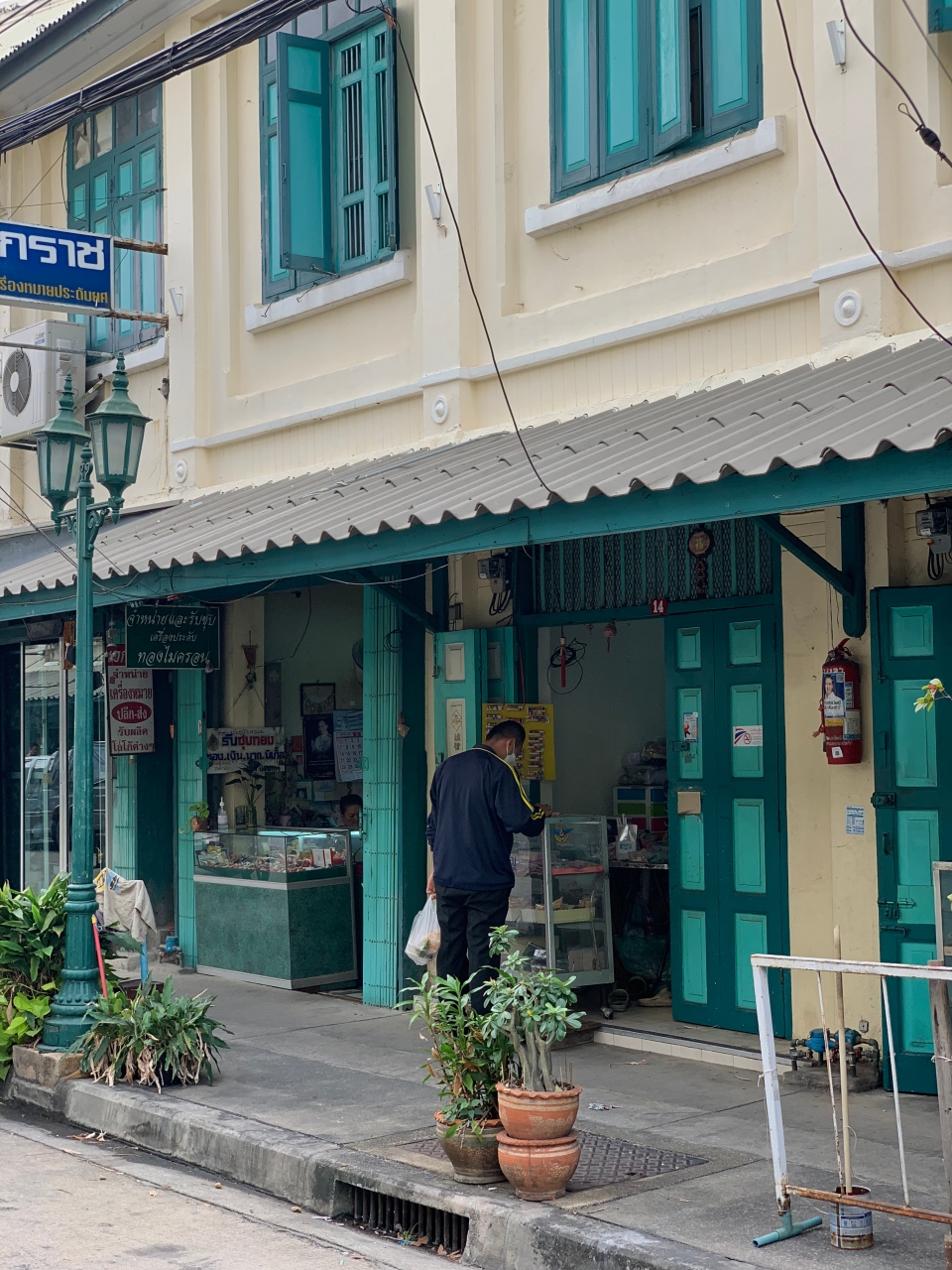

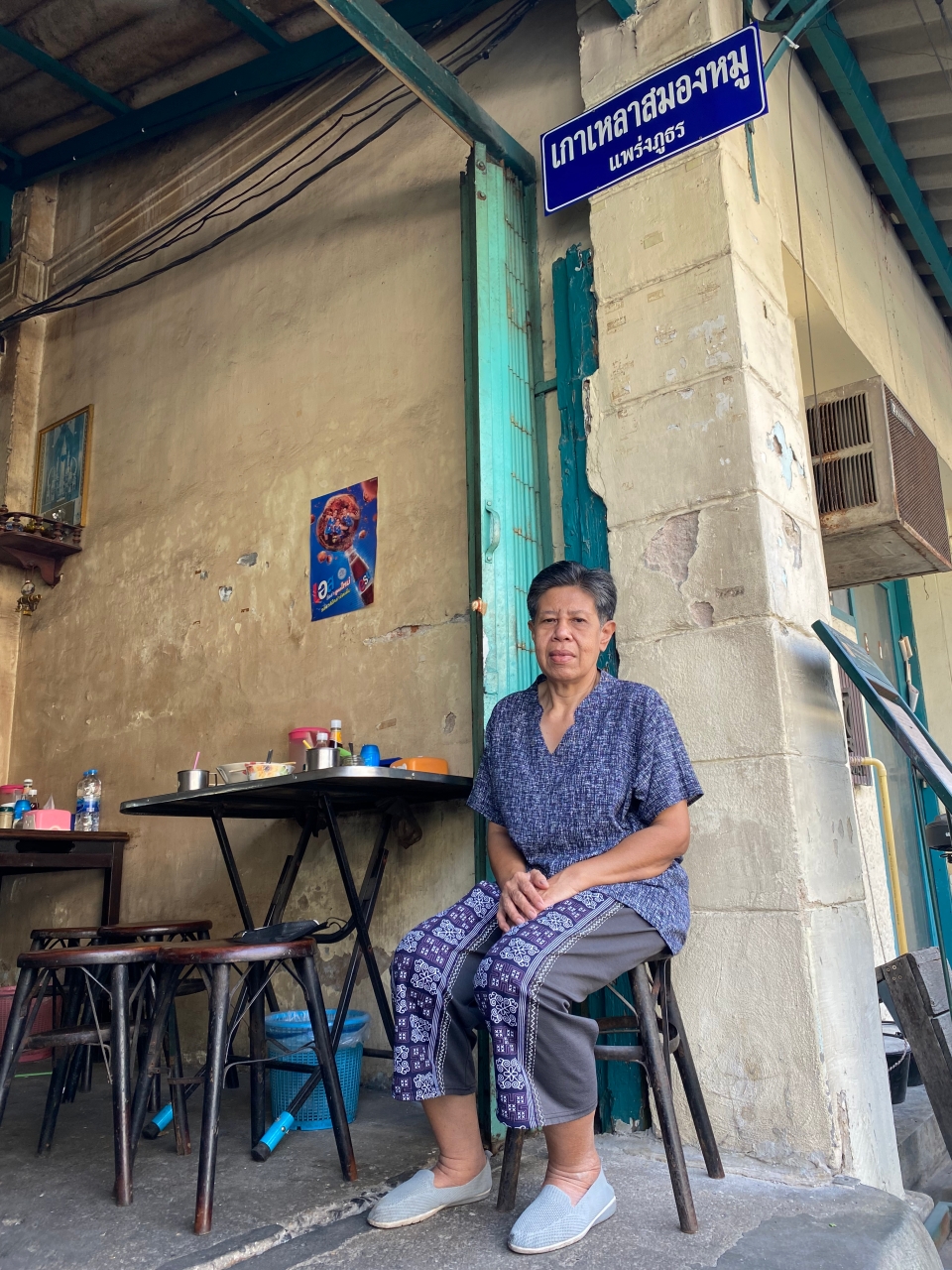
หากพูดถึง “แพร่งนรา” ย่านนี้จะเป็นถนนสายสั้นที่เรียงรายไปด้วยอาคารที่ถูกสร้างขึ้นโดยผสมผสานความเป็นไทยและฝรั่งเข้าด้วยกัน คล้ายกับแพร่งภูธร แต่เดิมเป็นเขตวังเก่าของพระเจ้าบรมวงศ์เธอกรมพระยานราธิปประพันธ์พงศ์ พระราชโอรสในรัชกาลที่ 4 และพระอนุชาของรัชกาลที่ 5 ในช่วงแรกนั้นท่านรับราชการตําแหน่งรองเสนาบดีกระทรวงพระคลังมหาสมบัติ แต่ภายหลังทรงลาออกจากราชการไปประกอบธุรกิจส่วนพระองค์ รวมถึงธุรกิจด้านบันเทิง ซึ่งก็คือโรงละครที่มีชื่อว่า “ปรีดาลัย”นั่นเอง
ต่อมาพระองค์ทรงตัดถนนแพร่งนราให้กว้างขึ้นเพื่อสร้างตึกแถวสําหรับให้เช่า ส่วนตัววังเองถูกเวนคืนเนื่องจากมีการสร้างถนนตัดผ่านส่วนกลางของวัง ในปัจจุบัน ส่วนที่เหลือจึงมีเพียงพระตําหนักไม้เก่าที่ถูกปรับให้เป็นโรงเรียนตะละภัฏศึกษาในภายหลัง
Speaking about "Phraeng Nara," this area is a short street surrounded by buildings constructed in a blend of Thai and Western styles, similar to those found in Phraeng Phuthorn. Initially, Phraeng Nara was the old palace district of Prince Narathip Praphanphong, the son of King Rama IV and the brother of King Rama V. At first, he held the position of Deputy Minister of Finance. Later on, he resigned from his official duties to pursue his personal business. Among them is the entertainment industry, specifically known as “Preedalai Theater.”
Phraeng Nara Street was also widened by Prince Narathip Praphanphong, who further commissioned the construction of row houses for rent. The palace itself was returned to the royal family, as a road was built through the central part of the palace. In present times, only the old wooden palace has been converted into a “Talaphat Suksa School” later on.
Contributed by
The Roots Routes
Cultural Experience Design Studio ที่เชื่อมโยงนักเดินทางกับชุมชนท้องถิ่น โดยการเล่าเรื่อง และให้ความเข้าใจในองค์ประกอบทางวัฒนธรรม ผ่านกระบวนการออกแบบ
A cultural experience design studio connecting travelers with local communities, emphasizing storytelling, and cultural immersion through the design process.
Phreang Supphasart
ส่องสถาปัตย์ซุ้มประตูและการหลอมรวมทางวัฒนธรรมผ่านห้วงเวลา
Gazing upon the traceable arch of the old palace and uncovering the melting pot of culture through the lens of time





Walking Path Overview
ส่งท้ายเส้นทางนี้ด้วยการเดินเที่ยวตามหาร่องรอยสถาปัตยกรรมอันสวยงามที่ยังหลงเหลืออยู่ผ่านเรื่องเล่าจากอดีตเพื่อค้นพบมุมมองใหม่ ๆในย่านนี้
Farewell to this route is the exploration of architectural remains through stories from the past that invite you to unveil new corners of perspective.


การผสมผสานสไตล์ตะวันตก สู่สถาปัตยกรรมแห่งแพร่งสรรพศาสตร์
Phraeng Supphasart’s architecture and its weaving of the West
รู้หรือไม่ ว่าวังวรวรรณของกรมพระยานราธิปประพันธ์พงศ์เคยถูกใช้เป็นโรงละครจริง ๆ และปัจจุบันก็ถือเป็นโบราณสถานแห่งหนึ่งของกรุงเทพฯ ด้วย วังแห่งนี้ถูกสร้างขึ้นราว พ.ศ. 2420–2430 ในช่วงสมัยรัชกาลที่ 5 ซึ่งถือว่าเป็นโรงละครสมัยใหม่แห่งแรกในไทยที่ได้รับอิทธิพลจากโรงละครโอเปร่าแบบตะวันตกที่มีที่นั่งสองข้างและมีทางเดินตรงกลาง
Did you know that Worawan Palace of Prince Narathip Praphanphong was once used as a theater and is now considered one of the ancient remains in Bangkok? Constructed during the times of King Rama V from 1877 to 1887, Worawan Palace stands as the first modern-era theater in Thailand, influenced by the style of European Opera theaters with two rows of seats and a central aisle inside.
“ละครปรีดาลัย” ที่วังวรรณถูกพัฒนามาจากละครไทยและตะวันตก ที่ผู้แสดงจะมีเพียงผู้หญิงและเป็นที่นิยมอย่างมากในสมัยรัชกาลที่ 6 และ 7 ต่อมาพระนางเธอลักษมีลาวัณ ซึ่งเป็นพระธิดาของกรมพระยานราธิประพันธ์พงศ์ได้เข้ามาดูแลต่อ แต่ภายหลังท่านได้ย้ายออกไปพํานักนอกพระนครฯ โรงละครแห่งนี้จึงได้ปิดตัวลงในราวปี พ.ศ. 2470 และตกไปอยู่ในความดูแลของสํานักงานทรัพย์สินส่วนพระมหากษัตริย์ จนปี พ.ศ. 2496 ได้ถูกเช่าเพื่อก่อตั้งโรงเรียนตะละภัฏศึกษาจนโรงเรียนปิดตัวลงในปี พ.ศ. 2538
วังนี้เป็นสถาปัตยกรรมครึ่งอิฐครึ่งไม้ผสมกับปูนซึ่งได้รับอิทธิพลจากศิลปะแบบ Neo Classic ของตะวันตกและมีทั้งหมดสองชั้น สิ่งที่อยากชวนให้สังเกตคือ ลวดลายไม้แกะสลักประดับส่วนต่าง ๆ ของอาคารที่มีความประณีตมาก ๆ คล้ายกับการตกแต่งขนมปังขิง เรียกว่าสไตล์ “บ้านขนมปังขิง” หรือ “Gingerbread House” นั่นเอง
The theatrical play “Preedalai" at Worawan Palace has developed from both Thai and Western dramas, featuring an all-female cast and soaring to fame during the reigns of King Rama VI and VII. This theater continued to prosper under the supervision of Princess Lakshamilavan, the daughter of Prince Narathip Prapanphong. However, after she moved out to reside outside Bangkok, the theater came to its final act around 1927 and fell under the management of the Crown Property Bureau until 1953. Later, it was leased to establish a "Talaphat Suksa School" until its closure in the year 1995.
This palace is a two-story structure made of a combination of half wood and half brick, inspired by the Neo-Classical style of the West. One distinctive feature worth observing is the delicately carved wood patterns that adorn various parts of the building, resembling the act of decorating gingerbread, often referred to as 'Gingerbread House' style.



เมื่อเดินต่อมาก็จะมาถึงย่าน แพร่งสรรพศาสตร์ ที่มีชื่อมาจาก พระนามของ “พระเจ้าบรมวงศ์เธอ กรมหลวงสรรพสาตรศุภกิจ” ” หนึ่งในพระโอรสของรัชกาลที่ 4 และเป็นพระอนุชาของรัชกาลที่ 5 ทรงโปรดเป็นอย่างมาก เพราะท่านมีความสามารถด้านการช่าง ถึงขนาดบังคับกรมช่างมหาดเล็ก ส่วน “ช่างทองหลวง” จึงทําให้เป็นที่เล่าลือกันว่าวังของท่านบริเวณแพร่งสรรพศาสตร์นี้มีความสวยงามกว่าวังอื่นๆเลยทีเดียว
ตามคําบอกเล่าของคนเก่าคนแก่ ตําหนักเดิมนั้นมีขนาดใหญ่โตมาก ประตูทางเข้าเป็นประตูบานใหญ่ที่ปูด้วยหินอ่อนตั้งแต่ทางเข้าวังไปจนถึงตัวตําหนัก เป็นที่พักของพวกฝรั่งและช่างทองในสมัยนั้น ส่วนที่สองของวังจะเป็นสวนและบัวที่ปลูกจนถึงตัวตําหนัก เมื่อท่านสิ้นพระชนม์ ทายาทได้ขายพื้นที่ของวังให้กับรัชกาลที่ 5 ที่ภายหลังสร้างเป็นตึกแถวลักษณะคล้ายกับแพร่งภูธรและแพร่งนรา
ตึกแถวแถบนี้แต่เดิมจะมีรูปร่างเพรียว ๆ ที่ชายคามีกระเบื้องยื่นออกมาทําเป็นขอบซีเมนต์ยาวตลอด มีเสาซีเมนต์สูงประมาณลําแขนตั้งเรียงเป็นแถวในช่วงห้องหนึ่ง ๆ ราว 4-5 เสา หัวเสาจะเป็นเหมือนบัวตูมเท่ากันเป็นที่กําหนดขนาดห้อง เวลามองขึ้นไปไม่เห็นกระเบื้องทําให้ดูงดงาม แต่ที่น่าเสียดายคือ ตึกแถวนี้ถูกไฟไหม้ใหญ่ถึง 2 ครั้ง ในปี พ.ศ. 2501 และ พ.ศ. 2510 เป็นเหตุผลว่าทําไมเราถึงไม่เห็นตึกเก่าที่สวยงามเหล่านี้ที่แพร่งสรรพศาสตร์ เหมือนอย่างสองแพร่งที่ผ่านมา จะเหลือก็แต่“ซุ้มประตูแพร่งสรรพศาสตร์” ด้านหน้าที่ติดถนนตะนาวนั่นเอง
Continuing on, you will arrive at "Phraeng Sapphasart," named after “His Royal Highness Prince Sapphasart Suphakit,” one of the sons of King Rama IV. Interestingly, he was the favored brother of King Rama V because of his exceptional artistic abilities, to the extent that he even directed the Department of Royal Craftman, especially in "The Royal Goldsmith Department" Therefore, there has been widespread acclaim that his palace in the Phraeng Sapphasart surpasses others in beauty, a testament to his outstanding craftsmanship.
From the sayings of the elderly, the old palace was immense, with a grand entrance door adorned with marble from the gate to the very core of the residence. The place served as a quarter for Western foreigners and goldsmiths during that era. The second part of the palace encompassed gardens and lotus ponds that extended to the center of the residence. After his passing, the heir sold the palace’s grounds to King Rama V, who later constructed shophouses similar in style to those in Phraeng Phuthorn and Phraeng Nara.
The original design of these shophouses was executed in a slender form, with overhanging tiles along the roof edge forming a long cement eave. There were tall cement pillars, roughly equating the size of our arms, arranged in rows within certain sections, approximately 4-5 columns in each row. Specifically, the column heads resembled bud-shaped lotus tips, working as indicators for room sizes. When viewed from below, it would create an aesthetically pleasing appearance as the tiles were not visible. Unfortunately, these shophouses encountered two major fires in 1958 and 1967, and that's why we no longer see these beautiful old buildings in Phraeng Sapphasart today, unlike in Phreang Phuthorn and Phraeng Nara. The only remnants are the "The Gate of Supphasart Suphakit Palace," located right by the Tanao street.



ซุ้มประตูแพร่งสรรพศาสตร์นี้ใช้ไม้ซุงเป็นคานขนาดใหญ่ สังเกตได้จากความหนาของตัวซุ้มประตู ด้านบนจะมีซุ้มกรอบประตูโค้งเป็น Arch ซึ่งเป็นลักษณะสถาปัตยกรรมจากฝรั่งเศส ตรงกลางจะมีประติมากรรมรูปหล่อเทพธิดากรีกยืนถือคบไฟอยู่ และทั้งสองข้างของรูปปั้นแบ่งเป็นช่องกระจกสี ความจริงแล้วประตูที่เราเห็นอยู่นี้ได้ถูกซ่อมแซมใหม่ โดยเฉพาะเสาค้ำยันด้านล่างที่เพิ่มแนวก่ออิฐเพื่อรับน้ําหนักด้านบน หากอยากรู้ความเป็นมาเพิ่มเติม สามารถหาแผ่นคําจารึกของประตูวังด้านข้างได้เลย!
และนี่ก็เป็นจุดสุดท้ายของเส้นทาง Royal Office Morning Stroll แล้ว เชื่อว่าหลาย ๆ คนคงได้ทั้งความรู้ และความสนุกไปไม่มากก็น้อย หวังว่าคุณคงจะได้มุมมองใหม่ ๆ เพิ่มเติมจากเรื่องเล่าสนุก ๆ จากอดีตที่ทําให้เห็นว่า ประวัติศาสตร์ ชุมชน ศิลปะและสถาปัตยกรรม มีความเกี่ยวข้องอย่างไรบ้าง เรื่องราวของประวัติศาสตร์ในย่านเมืองเก่าของกรุงเทพฯ ยังคงมีอีกหลายแง่มุมให้เราได้ไปสัมผัสกับอีก 2 เส้นทาง จาก CODE Studio และ Studio Us ถ้าหากพร้อมสนุกกันอีกก็กดเลือกเส้นทางต่อไปได้เลย
The Gate of Supphasart, characterized by its extensive use of large-sized teak wood, is noticeable in the thickness of the gate structure. At the top, the gate features an arch-shaped frame that draws influences from French architectural designs. In the center, you will witness a sculpted representation of a Greek goddess holding a torch, with stained glass panels being decorated on both sides of the sculpture. In reality, this gate has undergone new rebuildings, particularly the brickwork support pillar at the bottom designed to bear the weight above. For further details, you can also find inscriptions about the gate on the side walls!
And this concludes the final destination of our Royal Office Morning Stroll! We believe many of you have gained both knowledge and enjoyment to varying degrees. We hope you have garnered new perspectives from the interesting stories of the past that peel back the interconnected layers of history, community, art, and architecture. The historical narratives in the Bangkok Old Town neighborhoods remain many facets waiting for us to explore through two more routes available from CODE Studio and Studio Us. If you are all set for more adventure, don’t hesitate to go ahead and choose the next route!
Contributed by
The Roots Routes
Cultural Experience Design Studio ที่เชื่อมโยงนักเดินทางกับชุมชนท้องถิ่น โดยการเล่าเรื่อง และให้ความเข้าใจในองค์ประกอบทางวัฒนธรรม ผ่านกระบวนการออกแบบ
A cultural experience design studio connecting travelers with local communities, emphasizing storytelling, and cultural immersion through the design process.








